18. WORLD WAR TWO

AMERICA ENTERS THE WAR
CONTENTS
 The Atlantic Charter (August 1941) The Atlantic Charter (August 1941)
 Growing Japanese-American tensions Growing Japanese-American tensions
 "A date that will live in infamy" "A date that will live in infamy"
(December 7, 1941)
 The new United Nations The new United Nations
 America cranks up the industrial war America cranks up the industrial war
machine
 The war on the "Home Front" The war on the "Home Front"
The textual material on this webpage is drawn directly from my work
America – The Covenant Nation © 2021, Volume Two, pages 20-26.
|
A Timeline of Major Events during this period
| 1940s |
America is brought into the war
1941 America is so unhappy about Japanese action in China and Southeast Asia that it places an embargo on sales of oil, iron and other strategic goods to Japan (Jul)
Roosevelt meets Churchill at sea (Aug), to agree to mutual wartime goals (the Atlantic Charter) ... though America is officially at war with no one at that point
The Atlantic Charter will be adopted by many other countries (Sep) ...
and become the basis of the group termed the "United Nations"
Hitler continues
to ignore America's pro-British" neutrality" ... although a German
Uboat sinks an American
destroyer protecting a merchant convoy (Oct) ... leading Congress to
put aside its Neutraliy Acts
Japan, anxious to reach the resources of Dutch Indonesia – and worried about America's strategic position in the Philppines across Japan's path to those resources – decides to bring America to its knees by
knocking out America's Pacific fleet anchored in Hawaii (Dec); but
Roosevelt is not interested in
any form of surrender ... and gets Congress immediately to declare war
against Japan; a few
days later, Hitler foolishly decides to honor his pact with Japan and
declares war on America;
America is now fully involved in World War Two ... on two fronts,
Europe and the Pacific

|
THE ATLANTIC
CHARTER – AUGUST 1941 |
|
The Roosevelt-Churchill conference and the Atlantic Charter
(August 1941)
Whereas America was still a country at peace, it
had also become clear that the mood in the country was slowly shifting
to the idea of giving support (exemplified in Lend Lease) to the
countries struggling to hold off the aggressions of Fascism. Roosevelt
decided that it was time to discuss diplomatic goals (if not actual war
goals) that America might hold in common with Great Britain.
Thus in mid-August of 1941, Roosevelt met
with Churchill on a battleship anchored just off the Canadian coast to
discuss broad principles or goals that they both wanted to see pursued
in the struggles of the democracies against the dictatorships.
A week later Roosevelt sent a message to
Congress in which he outlined the basic principles agreed on at this
meeting with Churchill: no territorial gain or adjustments that did not
accord with the wishes of the people involved; self-government of all
people; equal access to world trade; economic cooperation for social
advancement; the rebuilding of Europe following the destruction of the
Nazi Empire; freedom of travel on the high seas; and a general
disarmament.
This Roosevelt-Churchill agreement was
issued at first simply as a Joint Declaration on August 14, 1941. This
was an amazing document, considering the fact that America was not
officially at war with anyone at that point. Yet it clearly laid out
war aims – in many ways resembling Wilson's Fourteen Points, which he
had hoped a generation earlier would direct warring parties to a new
and just global peace.
The broader impact of the Atlantic Charter: The "United Nations"
The following month (September) this
document was put forward and unanimously adopted at a meeting in London
of Great Britain and her wartime allies – the governments-in-exile of
Belgium, Czechoslovakia, Greece, Luxembourg, the Netherlands, Norway,
and Poland, plus representatives from the Soviet Union and Yugoslavia,
and the non-Vichy Free French (representing General de Gaulle) as a
basis of a common set of wartime goals. Thus this agreement proved to
be one of the first steps towards the formation of the United Nations
(at that time describing only a grand military alliance). Also, by this
time the document was being referred to as the Atlantic Charter.1
The Axis Powers interpreted these
diplomatic agreements as a potential alliance against them. Adolf
Hitler saw it as evidence of collusion between the UK and the USA, even
as an international Jewish conspiracy. In the Japanese Empire, the
Atlantic Charter rallied support for the militarists in the government,
who pushed for a more aggressive approach to the UK and US.
1Official
statements and government documents imply that Churchill and FDR signed
the Atlantic Charter. Actually, no signed copies are known to exist. A
British writer, H V Morton, who traveled with Churchill's party on the
Prince of Wales, states that no signed version ever existed. The
document was thrashed out through several drafts, says Morton, and the
finalized text was telegraphed to London and Washington. The British
War Cabinet replied with its approval and a similar acceptance was
telegraphed from Washington.
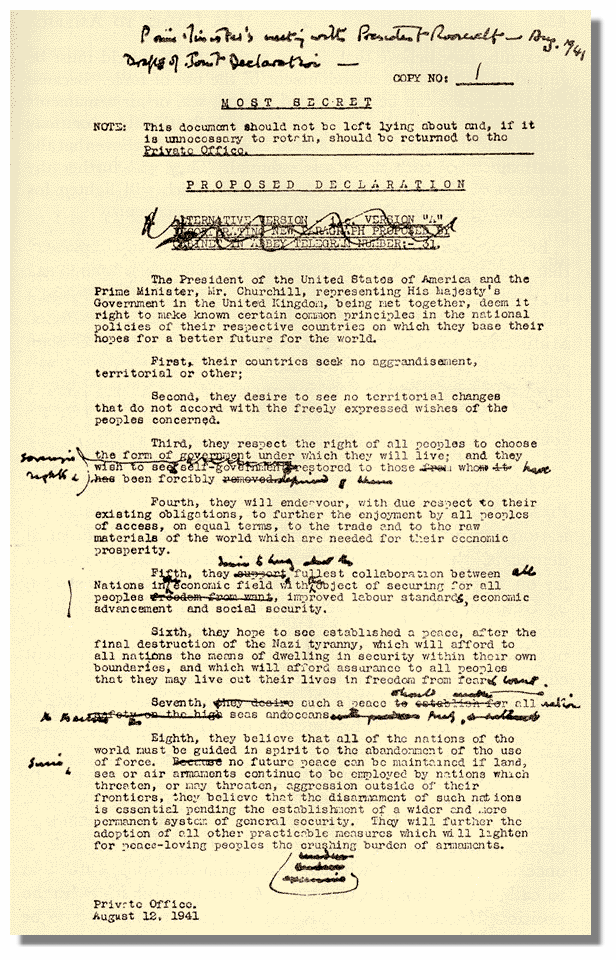 Winston Churchill's edited copy of the final draft of the
charter
Winston Churchill's edited copy of the final draft of the
charter
No territorial gains. First, their countries [The United States and Great Britain] seek no aggrandizement, territorial or other;
Territorial adjustments. Second, they desire to see no territorial changes that do not accord with the freely expressed wishes of the peoples concerned;
Self-government.
Third, they respect the right of all peoples to choose the form of
government under which they will live; and they wish to see sovereign
rights and self government restored to those who have been forcibly
deprived of them;
Equal access to world trade.
Fourth, they will endeavor, with due respect for their existing
obligations, to further the enjoyment by all States, great or small,
victor or vanquished, of access, on equal terms, to the trade and to
the raw materials of the world which are needed for their economic
prosperity;
Economic cooperation.
Fifth, they desire to bring about the fullest collaboration between all
nations in the economic field with the objector securing, for all,
improved labor standards, economic advancement and social security;
A post-Nazi peace.
Sixth, after the final destruction of the Nazi tyranny, they hope to
see established a peace which will afford to all nations the means of
dwelling in safety within their own boundaries, and which will afford
assurance that all the men in all the lands may live out their lives in
freedom from fear and want;
Freedom of travel on the high seas. Seventh, such a peace should enable all men to traverse the high seas and oceans without hindrance;
General disarmament.
Eighth, they believe that all of the nations of the world, for
realistic as well as spiritual reasons, must come to the abandonment of
the use of force. Since no future peace can be maintained if land, sea
or air armaments continue to be employed by nations which threaten, or
may threaten, aggression outside of their frontiers, they believe,
pending the establishment of a wider and permanent system of general
security, that the disarmament of such nations is essential. They will
likewise aid and encourage all other practicable measures which will
lighten for peace loving peoples the crushing burden of armaments.
|
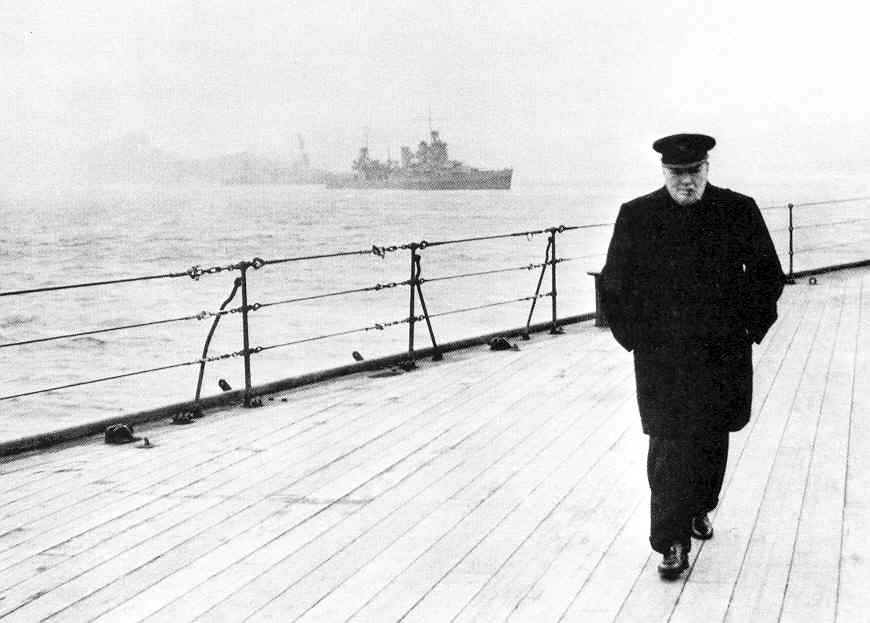
Winston Churchill aboard
HMS Prince of Wales off Newfoundland at the time of the Atlantic
Charter meeting with Roosevelt
 USS McDougal
(DD-358) alongside HMS Prince of Wales, to transfer President
Franklin
D. Roosevelt to the British battleship for a meeting with Prime Minister
Winston Churchill. Photographed in Placentia Bay, Newfoundland.
Donation of Vice Admiral
Harry Sanders, USN (Retired), 1969.
USS McDougal
(DD-358) alongside HMS Prince of Wales, to transfer President
Franklin
D. Roosevelt to the British battleship for a meeting with Prime Minister
Winston Churchill. Photographed in Placentia Bay, Newfoundland.
Donation of Vice Admiral
Harry Sanders, USN (Retired), 1969.
U.S. Naval Historical Center
Photograph

British Prime Minister
Winston Churchill meets with President Franklin D. Roosevelt on board USS
Augusta
(CA-31), off Argentia, Newfoundland, August 9, 1941.
Assisting the President is his son, Army Captain Elliot Roosevelt.
D. Roosevelt, Jr., USNR, is at left.
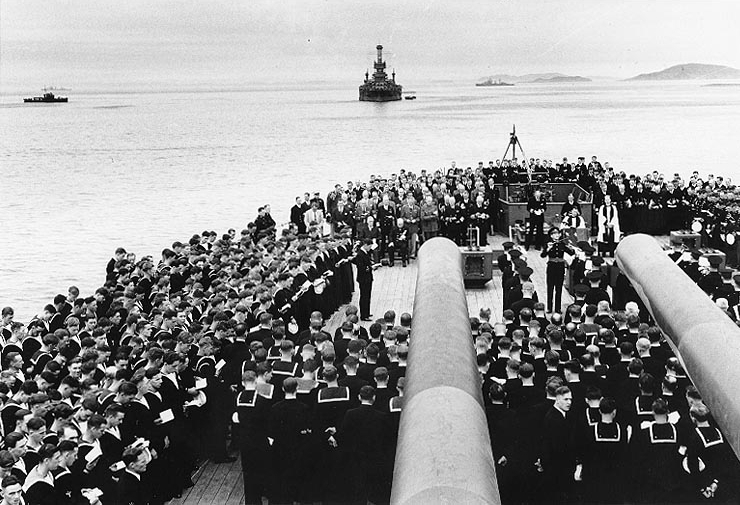
Church service on the
after deck of HMS Prince of Wales, in Placentia Bay, Newfoundland,
during the conference.
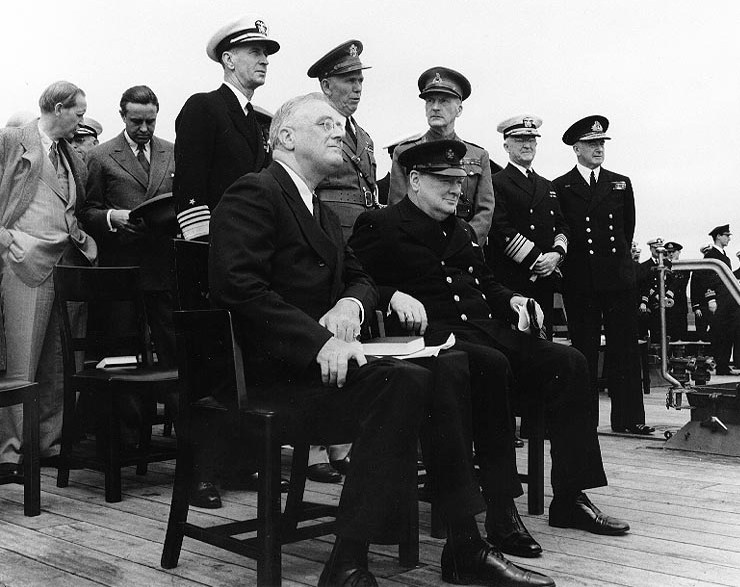 FDR and Churchill worshiping
together aboard the Prince of Wales. Standing directly behind
them are Admiral Ernest J. King, USN; General George C. Marshall,
U.S.
Army; General Sir John Dill, British Army; Admiral Harold R. Stark,
USN; and Admiral
Sir Dudley Pound, RN. At far left is Harry Hopkins,
talking with W. Averell Harriman.
FDR and Churchill worshiping
together aboard the Prince of Wales. Standing directly behind
them are Admiral Ernest J. King, USN; General George C. Marshall,
U.S.
Army; General Sir John Dill, British Army; Admiral Harold R. Stark,
USN; and Admiral
Sir Dudley Pound, RN. At far left is Harry Hopkins,
talking with W. Averell Harriman.
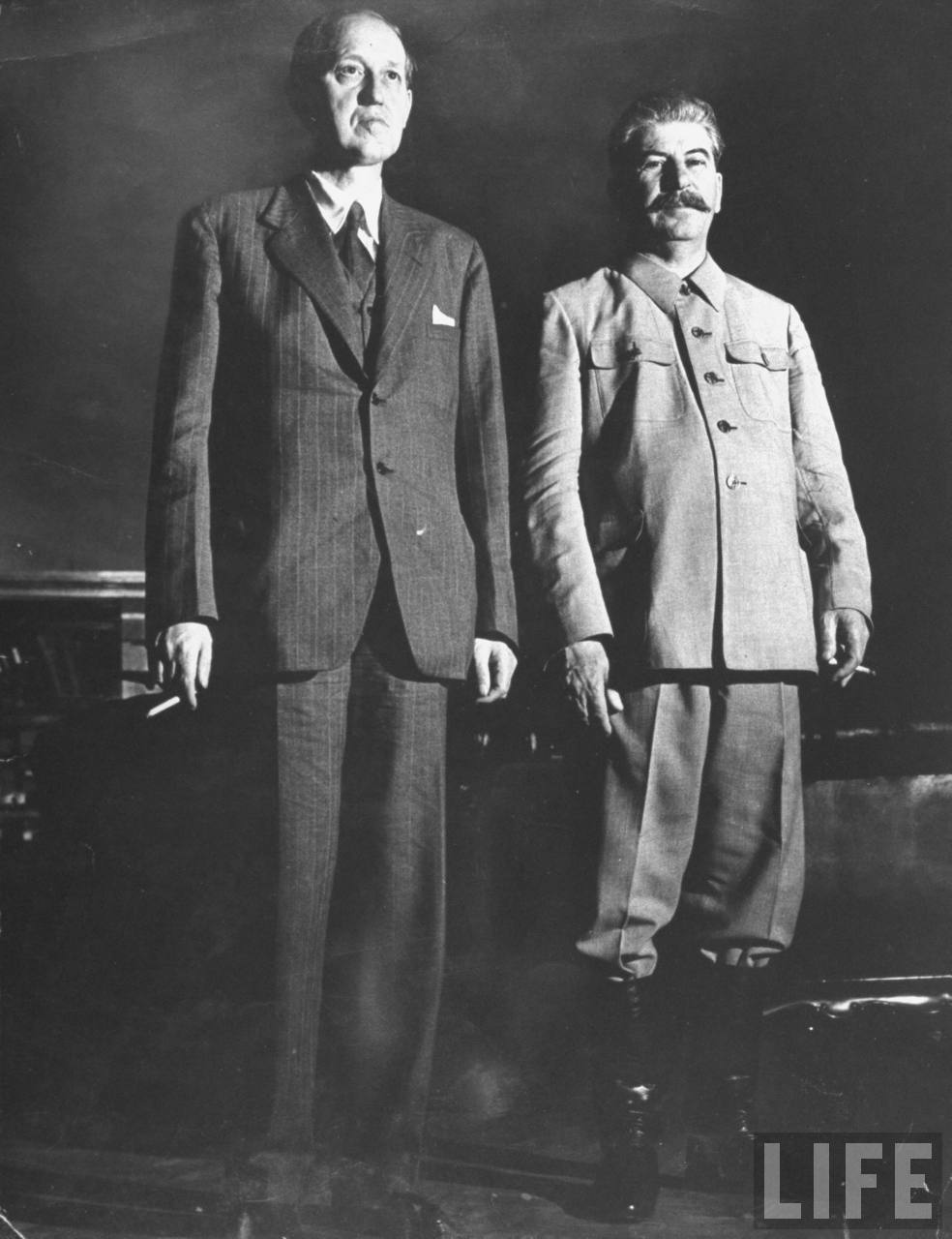 Harry Hopkins meets with
Stalin to investigate the possibilities of working together against Hitler – August 1941
Harry Hopkins meets with
Stalin to investigate the possibilities of working together against Hitler – August 1941
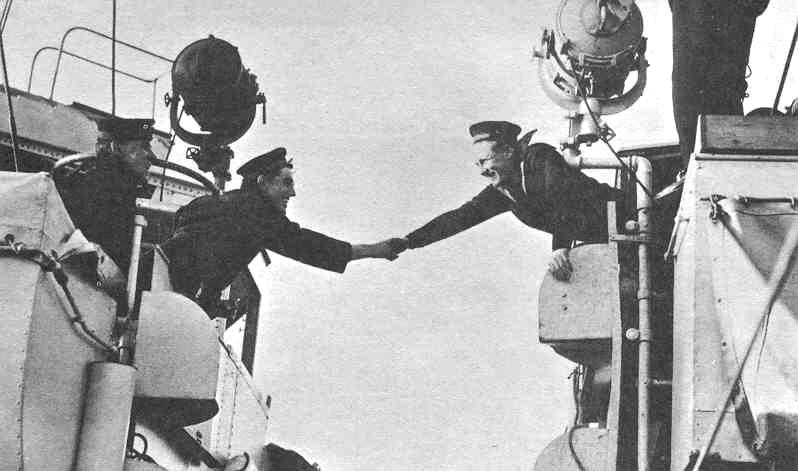 British sailors congratulating
each other for having brought over 2 of 50 "mothballed" American
destroyers
British sailors congratulating
each other for having brought over 2 of 50 "mothballed" American
destroyers
GROWING JAPANESE-AMERICAN TENSIONS |
|
With France's fall to Germany in June of 1940 and
the creation of the Vichy Government in southern France, the French
colony of Indochina was only weakly held by the French. The Japanese
took advantage of this weakness, demanding of the Vichy government
access to Indochina in order to have a base from which to move against
the Chinese enemies in the South of China.
America was alarmed by this expansion of
Japanese power into Indochina and in July decided to place an embargo
on the sale of strategic goods (aircraft parts, key minerals, oil and
scrap iron) to Japan, irritating Japan immensely. This, plus
anti-Japanese racial attitudes reflected in American limits on Japanese
immigration, infuriated the Japanese military leaders, who were
suffering from some of the same racial illusions of greatness that had
infected the Nazis.
The Japanese military leaders, who
dominated all Japanese politics, were themselves divided on what to do
about the "American problem." Eventually General Hideki Tojo and his
group won the day (with the help of the Emperor Hirohito) and readied
Japan to deliver a huge crippling blow that they were certain would
force America to have to sue for peace – entirely on Japanese terms.
The Japanese would take out the American naval fleet stationed at Pearl
Harbor, destroying all American capabilities in the Pacific and Asia.
At the same time, they would seize the oil-rich Dutch East Indies – and
all the lands along the way, principally the American-protected
Philippines, independent Thailand, British Malaya and the British naval
base at Singapore. The French government at Vichy, forcibly allied with
Hitler's Nazi Germany, had already given its permission to the Japanese
to occupy French Indochina (Vietnam, Laos and Cambodia).
Not all the Japanese were certain that
this plan would work, notably Admiral and Commander-in-Chief of the
Japanese navy, Isoroku Yamamoto, who had studied for two years at
Harvard and who offered the opinion that if this strike did not work as
planned, the endeavor would succeed only in awakening a sleeping lion,
with dire results for Japan. Nonetheless he submitted himself to the
majority of his military colleagues and went along with the plan.
|
The Japanese prepare themselves
for a major offensive against the Western democracies in Asia and the Pacific
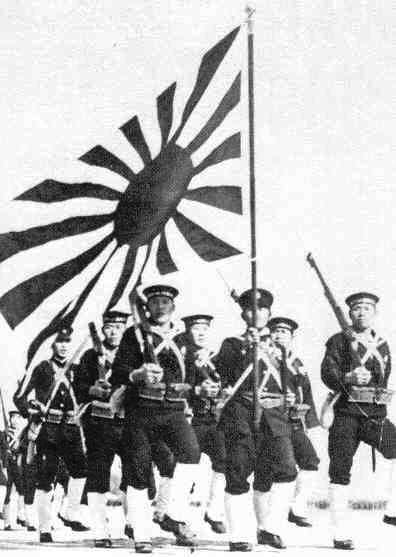 Imperial
Marines
Imperial
Marines
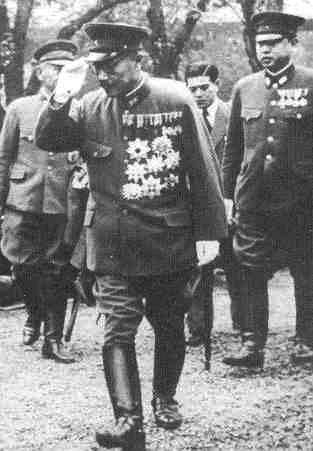 Gen. Hideki
Tojo
Gen. Hideki
Tojo
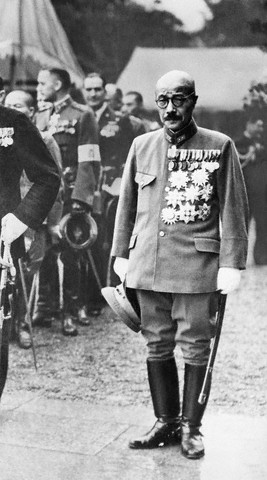
Hideki Tojo, Prime Minister
of Imperial Japan (October 1941–July 1944)
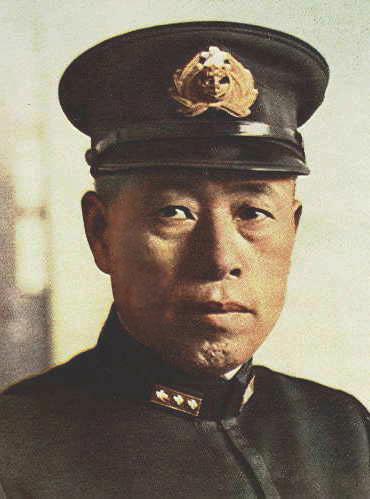
Isoroku Yamamoto, Japanese
Fleet Admiral
"A DATE WHICH WILL LIVE IN INFAMY" |
|
Thus at dawn on Sunday morning, December 7th, 1941, without a declaration of war or any warning2
to the Americans, Japanese carrier-based airplanes attacked the Pearl
Harbor naval station, sinking all the battleships anchored there and
wiping out nearly all of the airplanes still parked at the air station.
But the attack had an effect quite opposite what the Japanese had
intended. Instead of forcing America to cringe before Japanese power,
the attack pushed America overnight to a willingness to become a
dedicated fighting nation.
On the following day, December 8th,
Roosevelt stood before Congress to request a declaration of war against
Japan. His speech was unlike Wilson's 1917 speech with Wilson's lofty
rhetoric of high ideals (which Americans by this time were highly
suspicious of) but instead a simple reference to the criminality of
Japan's behavior, begun simply with the statement,
Yesterday,
December 7, 1941 – a date which will live in infamy – the United States
was suddenly and deliberately attacked by naval and air forces of the
Empire of Japan.
He mentioned the treachery of the
Japanese in pretending to be negotiating for peace when in fact Japan
had already decided days before to attack America. He did not gloss
over the huge loss of life and military equipment, and pointed out that
this was part of a wider Japanese aggression, timed with an attack in
the Philippines and other areas in the Pacific. His appeal was strictly
to the sense of national outrage, and to the American spirit that would
never let Japan get away with such treachery. Thus:
As Commander in Chief of the Army and Navy, I have directed that all measures be taken for our defense.
But always
will our whole nation remember the character of the onslaught against
us. No matter how long it may take us to overcome this premeditated
invasion, the American people in their righteous might will win through
to absolute victory.
I believe
that I interpret the will of the Congress and of the people when I
assert that we will not only defend ourselves to the uttermost but will
make it very certain that this form of treachery shall never again
endanger us.
Hostilities exist. There is no blinking at the fact that our people, our territory and our interests are in grave danger.
With
confidence in our armed forces, with the unbounded determination of our
people, we will gain the inevitable triumph so help us God.
There it was, plainly said. We
Americans would fight – not to save the world for some kind of high
ideal, but rather to defend ourselves from the treachery that
threatened us, our territory, our interests. It was a hard and precise
piece of political realism. And we were ready to back that declaration
– with our lives – so help us God.
Congress's vote for war was unanimous
in the Senate and only one vote short (Liberal feminist Jeanette Rankin
opposed) of being unanimous in the House. At 4:00 p.m. on the 8th of
December America was formally at war, though at this point only against
the Japanese.
Hitler declares war on America
Several days later Hitler, puffed up
with his growing sense of military genius, announced that he was
respecting the Tripartite Pact with Japan in declaring that a state of
war now existed between Germany and the United States. So whatever
America's hesitant feelings had been previously about the war in
Europe, they no longer mattered. By Hitler's own bizarre decision,
America was at war not only with the Japanese but also with the Germans.
"With God's help, we will triumph"
This was not a good time for America to
be getting into a war against two successful empires, with few proven
allies for America to count on (France had been knocked out; Great
Britain and Russia were not looking very good at this point) and
America's own military was in a deplorable state of unpreparedness. But
the spirit of America in 1941 was such that Americans chose not to look
at the situation as worldly eyes would see things (very bad indeed) but
as the higher vision of God might see things: the need to take a stand
against evil – and trust in God to support us in our struggle. When
Roosevelt added the words "so help us God" at the end of his address
requesting of Congress a declaration of war, that was not merely
religious cant, that was an important call to connect "the unbounding
determination of our people" with the vital aid and guidance of God.
America was determined to gain the inevitable triumph ..."so help us
God."
2Japanese
civilian diplomats had been in Washington claiming to want to negotiate
an improvement in Japanese-American relations, when they were
instructed instead to deliver a declaration of war. But they were still
working on a translation of the declaration when the attack got
underway in Hawaii.

Captured Japanese photograph taken aboard
a Japanese carrier before the
attack on
Pearl Harbor,
Hawaii, December 7, 1941. Photograph from a Japanese
plane of Battleship Row at the beginning of the attack. The explosion in the center
is a torpedo strike on the USS Oklahoma
Photograph from a Japanese
plane of Battleship Row at the beginning of the attack. The explosion in the center
is a torpedo strike on the USS Oklahoma

Captured Japanese photograph taken during
the December 7, 1941, attack on Pearl Harbor. In the distance,
the
smoke rises from
Hickam Field.
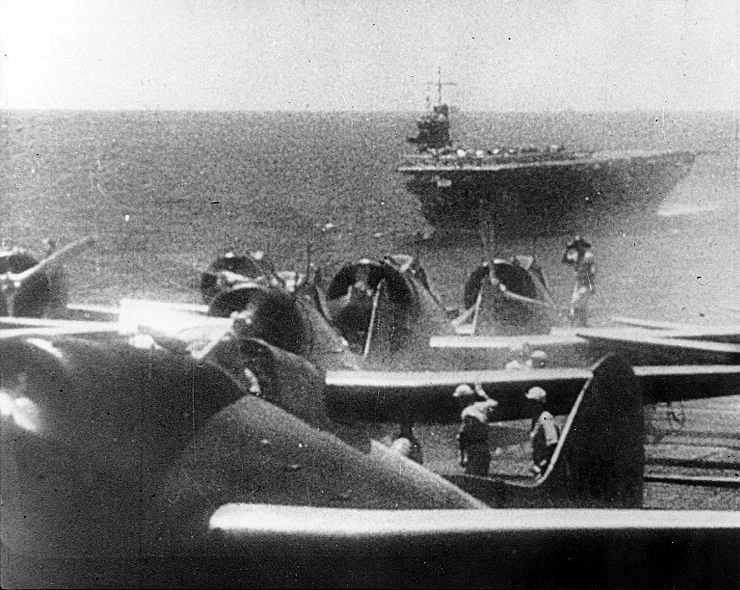
Japanese Aichi D3A1 "Val"
dive bombers of the second wave preparing for take off. Aircraft carrier Soryu
in the background.
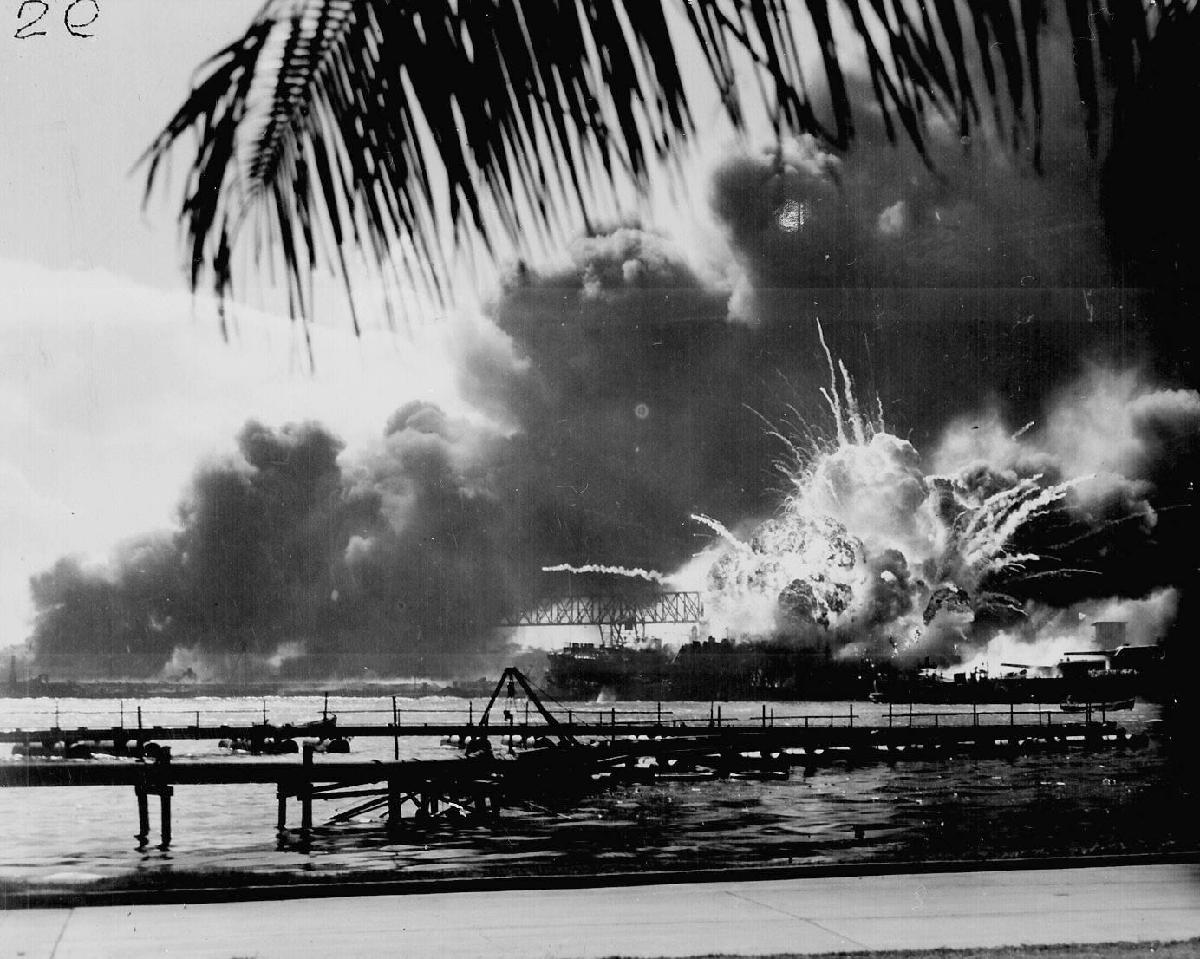
"USS Shaw (DD-373)
exploding during the Japanese raid on Pearl Harbor."
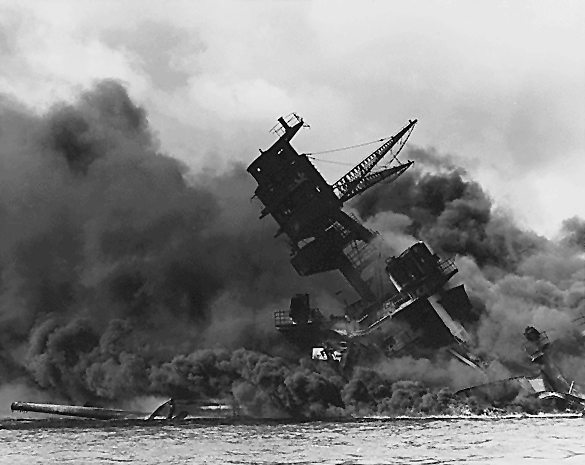
The USS Arizona (BB-39)
burning after the Japanese attack on Pearl Harbor, 7 December 1941. USS Arizona sunk
at Pearl Harbor. The ship is resting on the harbor bottom. The supporting
structure
of the forward tripod mast has collapsed after the forward magazine
exploded.
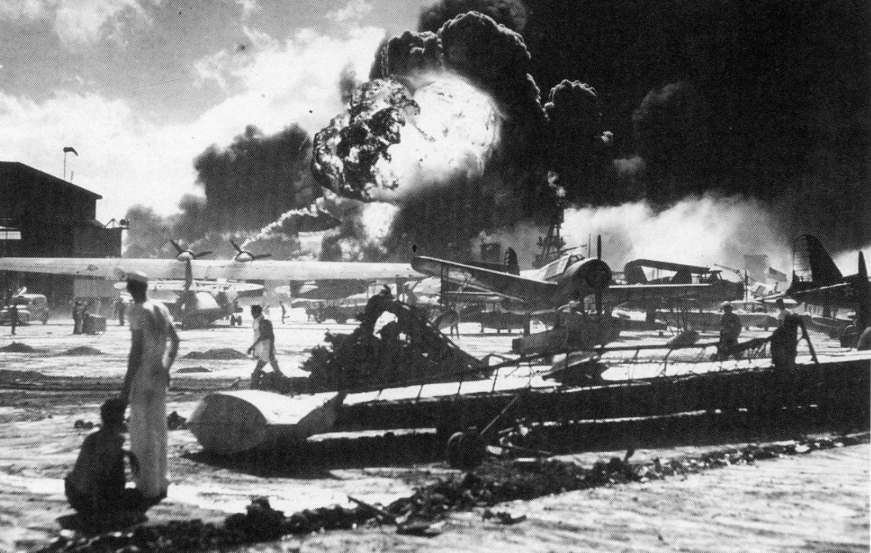
The US Naval Air Station
at Pearl Harbor under Japanese attack
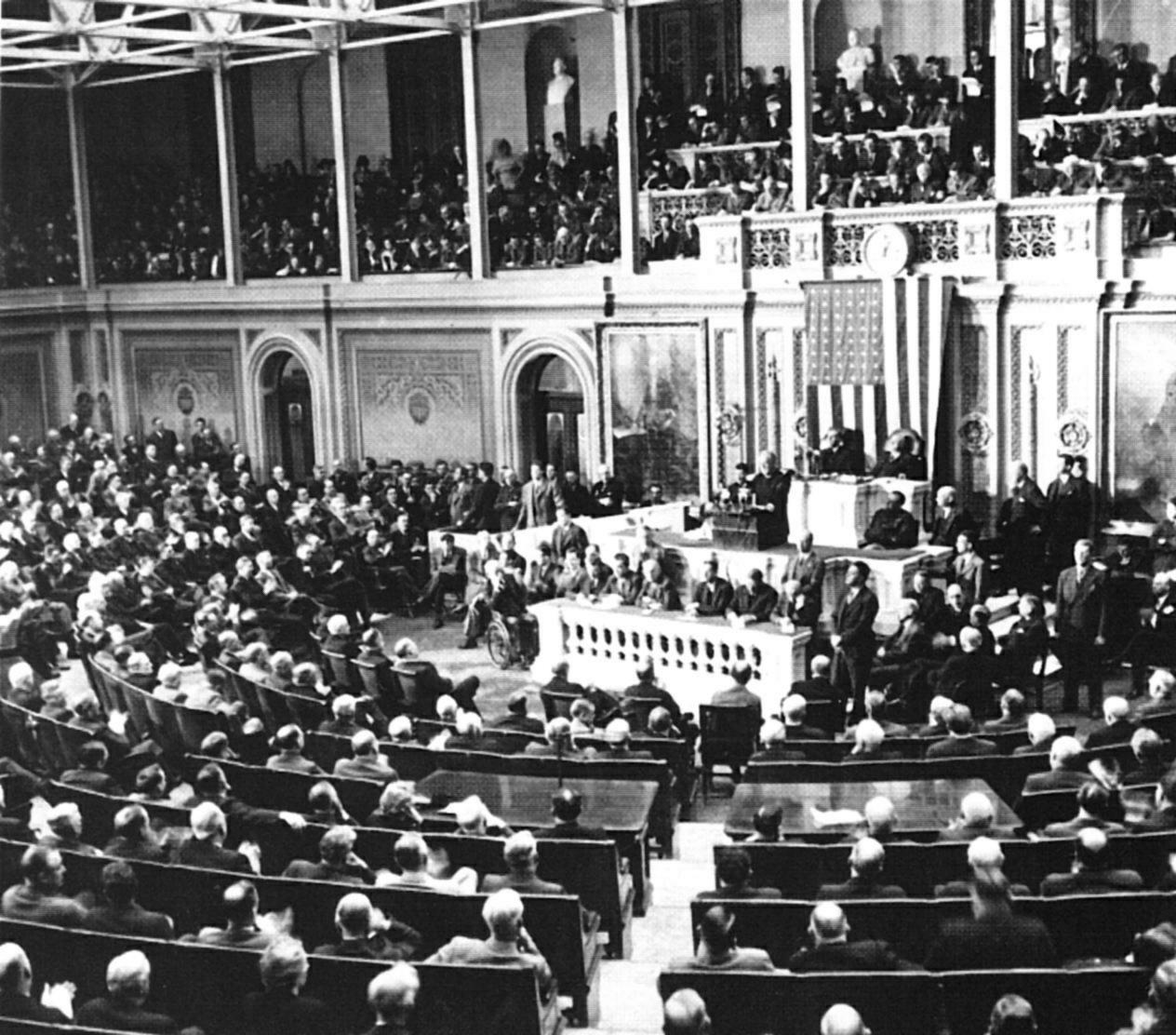
Franklin Roosevelt asks Congress
to declare war on Japan – December 8, 1941
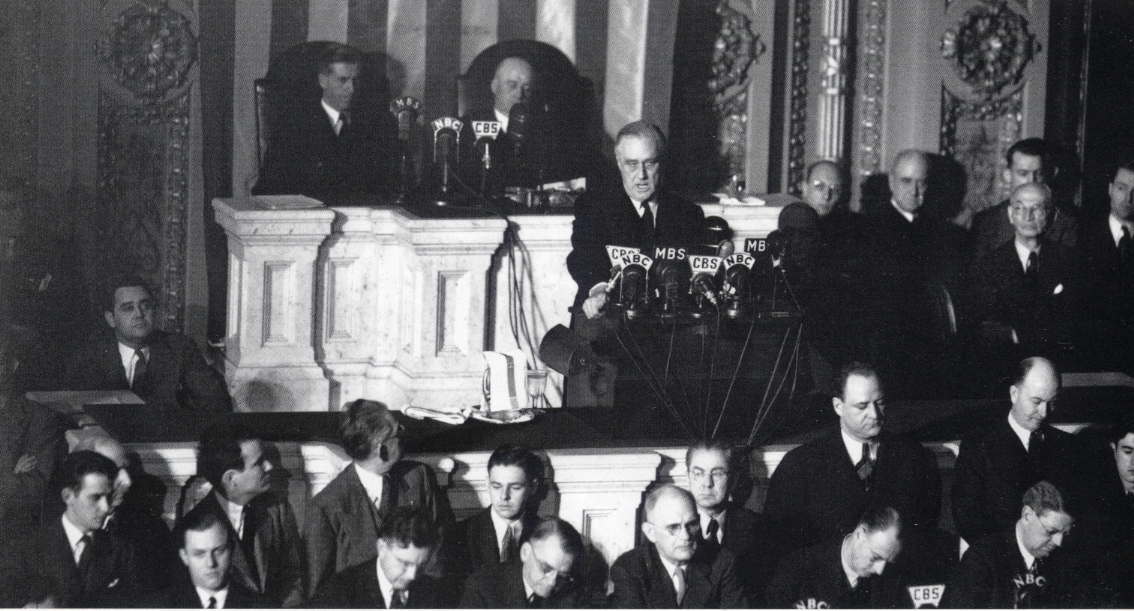
At 4 P.M. that same
afternoon,
President Roosevelt signed the declaration of war. Furious at the
brutal attack and drawing inspiration from Roosevelt's address, the American
people united behind a massive mobilization for war.<

President Roosevelt signing
the declaration of war against Japan – December 8, 1941
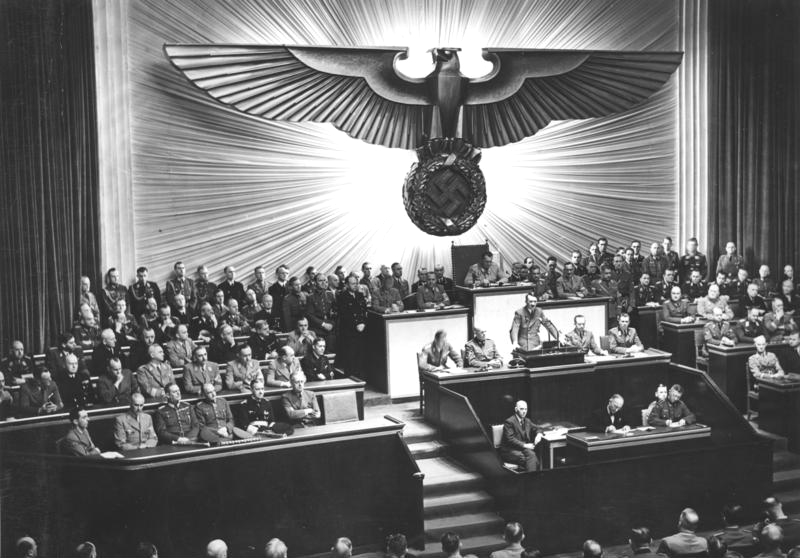
Adolf Hitler delivers a speech
to the Reichstag on the subject of Roosevelt and the war in the Pacific, declaring war on the United
States – December 11, 1941
|
The Atlantic Charter as the moral foundation of the new United Nations
On January 1st, 1942, the United Nations of
twenty-two countries around the world were formed into an alliance in
order to oppose the Fascist or Axis nations of Germany, Italy and
Japan. These United Nations – led by the Big Four of America, Great
Britain, Russia and China – signed the Atlantic Charter as a joint
Declaration by the United Nations and committed themselves to pursue the
war with the aim of a total victory against the Fascist enemy. Over the
next few years an even greater number would sign on as members of the
"United Nations."
The major guiding principles of this new
military alliance, the United Nations, were to be those of the Atlantic
Charter. This document would also become a foundational document for
the organization of that same name that would be formed at war's end.
The Atlantic Charter and Declaration
outlined how an anti-Fascist military alliance was to operate – and how
a post-war world would be shaped and also operate. The latter part
would be particularly important in the way in which after the war much
of the world would indeed take shape, especially economically.
However, politically the Atlantic Charter
would ultimately prove to be much more Idealistic than any of the great
powers, when pressed for specifics, were willing to support at the end
of the War. This was particularly the case again with respect to the
rights of national self-determination of people (the old Wilsonian
ideal). Germany would lose a lot of its ethnic territory (which Poland
would gain after expelling its German population); Russia's grab and
absorption into the Soviet Union of the Baltic countries of Estonia,
Latvia and Lithuania and the eastern half of Poland would be left
unchallenged; Indochina would remain in French hands (Vietnam would not
be granted the national independence it sought); Indonesia would remain
in Dutch hands, etc.
|
America was back in business again, very focused
on the clear goal of defeating – at all costs – the Fascism that had
destroyed the peace of the world.
And to get the job done, a much-revived
private capitalism was going to work very closely with Roosevelt's
rather socialist state, in producing the means to destroy enemy
Fascism. Under such cooperation, the federal government funded the
building of new industrial plants, encouraged industrial producers to
work together (and thus had to suspend the antitrust laws outlawing
just such behavior) in order to optimize war production, much to the
annoyance of some of FDR's New Deal supporters who still considered
industrial capitalism to be a vile philosophy!
Industrial production got off to a
relatively slow start, but picked up the pace rapidly. Automobile
plants switched to the production of war goods, such as Chrysler, which
turned to the mass production of tanks. Industrial companies grew
rapidly and in the last years of the war were producing war goods at an
astronomical rate. For instance, the Calship Yards in Los Angeles in
the last year of the war (January-August 1945) alone produced 247
Victory ships, more than one huge ship coming into operation per day.
In Stratford Connecticut, another industrial company alone produced
some 6,000 corsair fighter planes during the course of the war.
With men entering military service in
mass numbers, the country now found itself short in manpower, and
turned to womanpower. The country's vocational schools turned to the
converting of traditional secretaries, housewives, etc. into
assembly-line specialists, welders in shipyards, etc. Indeed, the
Women's Army Corps had WACs fly bombers from American assembly plants
to airfields overseas (principally England) to put them in the hands of
the men who would then conduct the bombing runs over German-occupied
Europe.
|
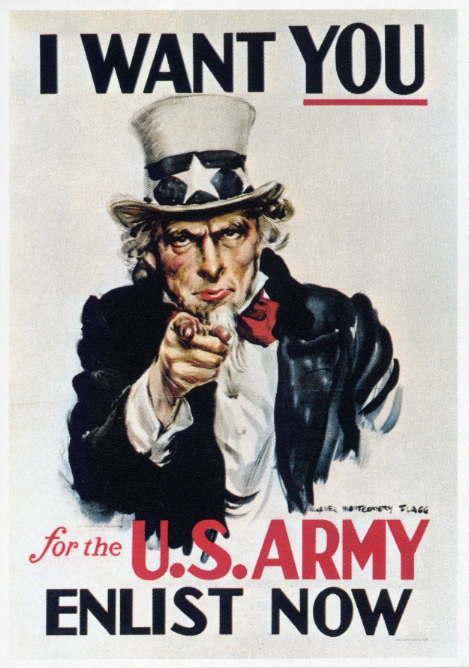
An Army recruiting poster
(same one used in World War One!)
Library of
Congress
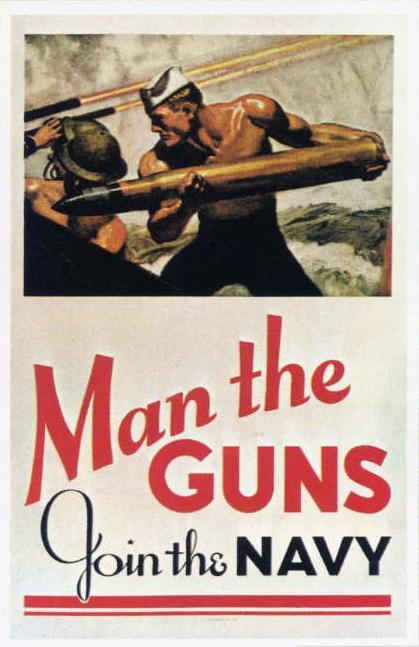 A Navy recruiting poster
A Navy recruiting poster
Library of Congress
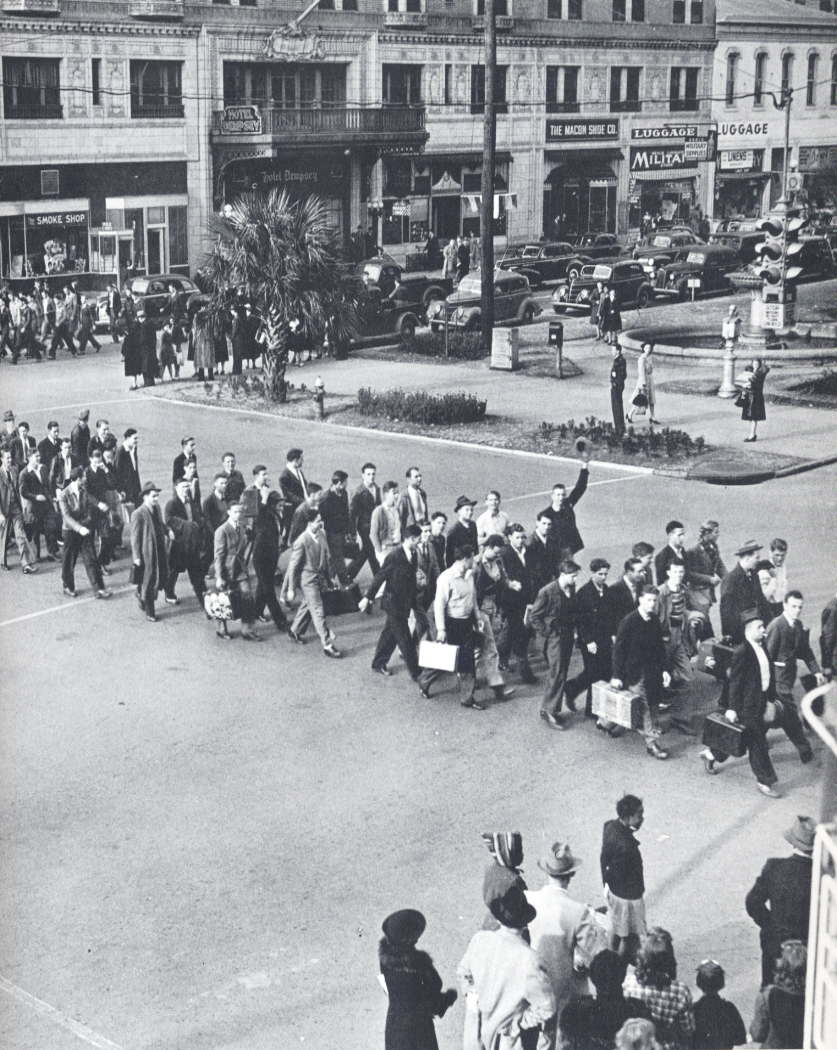
New recruits in Macon, Georgia,
heading off to training in Virginia
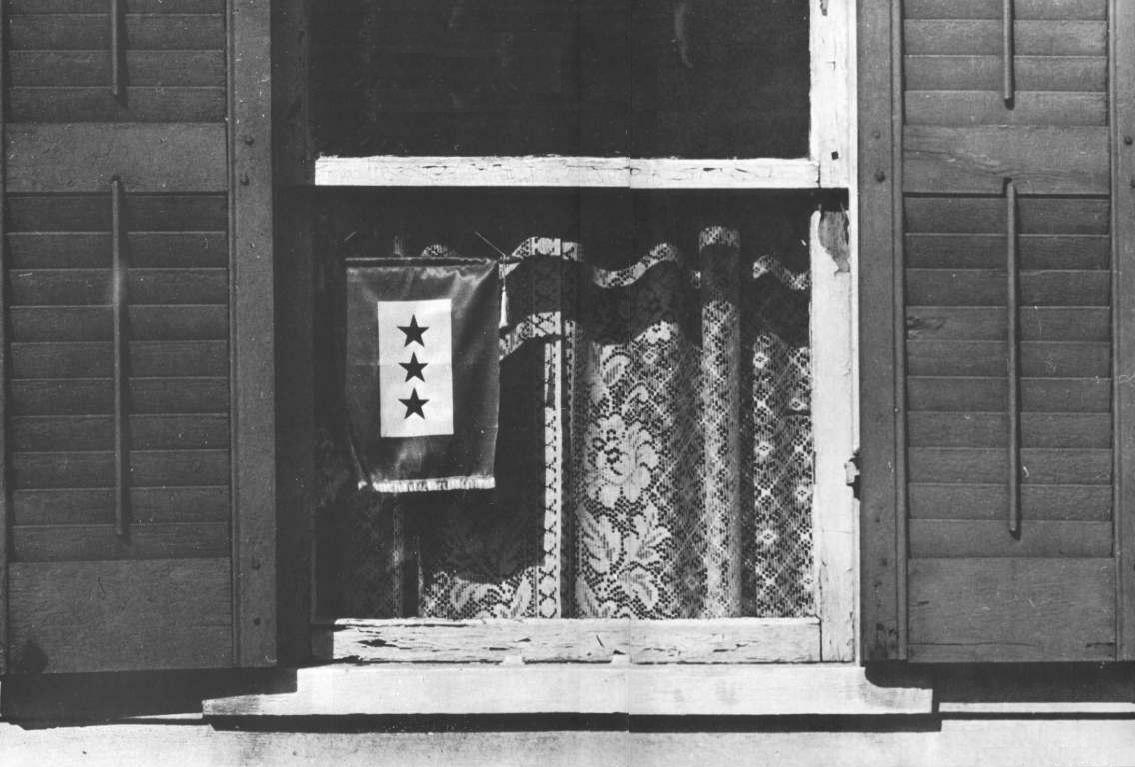
A Home with three men in
the armed service
Library of Congress
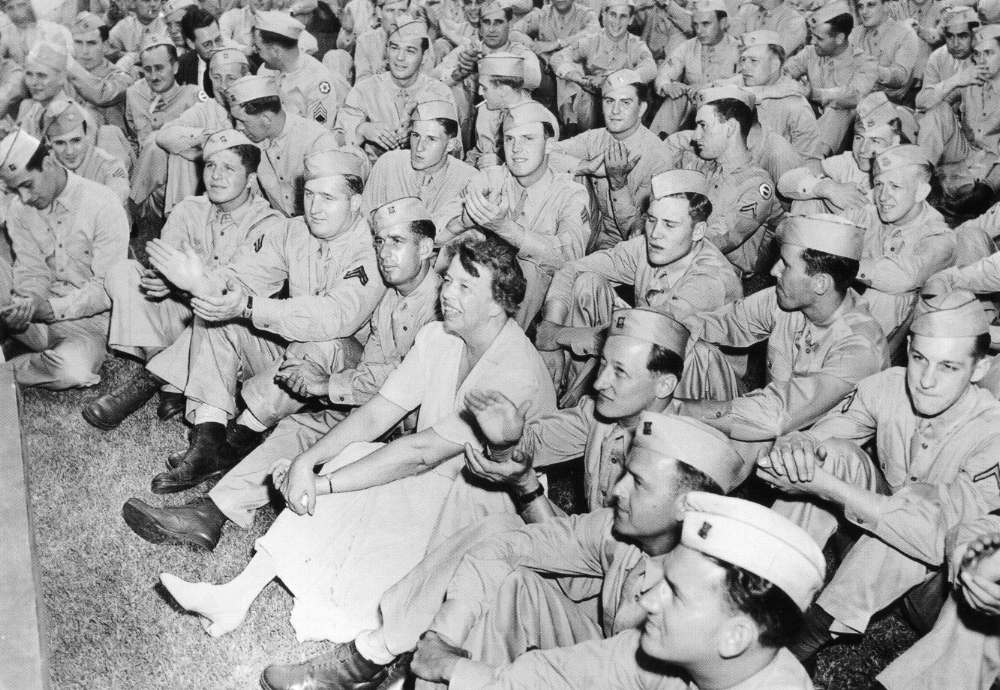
Eleanor Roosevelt with US
troops – 1942
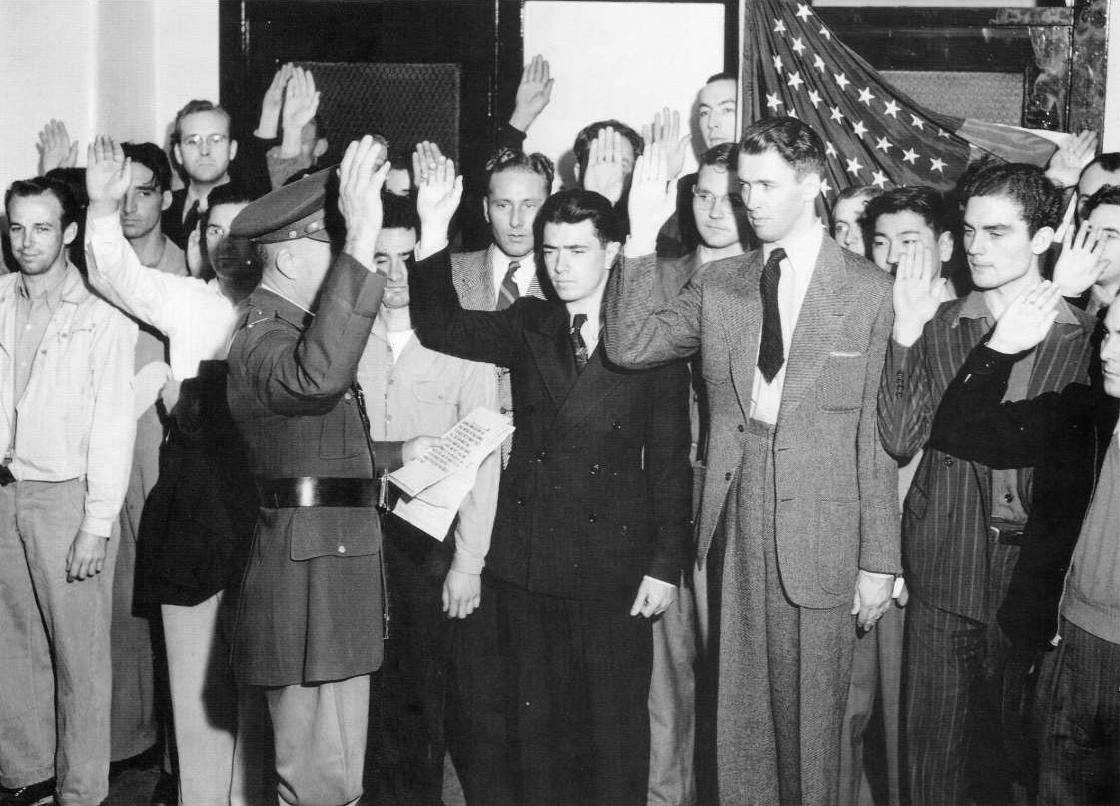
Hollywood actor (age 33) Jimmy
Stewart
joining the Army in March of 1941
(8 months before Pearl
Harbor)
He had just won the 1940
Oscar for his part in The Philadelphia Story. He
was of an old Pennsylvania military family, and had already clocked in
over 400 hours of flight time. He would become a highly decorated
Army Air Corps bomber pilot and full colonel in rank, having
officially led 20 bombing missions over Germany (and others
unofficially!). He would eventually retire from the Air Force
Reserves in 1968 as a Major
General. |
CRANKING UP THE INDUSTRIAL WAR MACHINE |
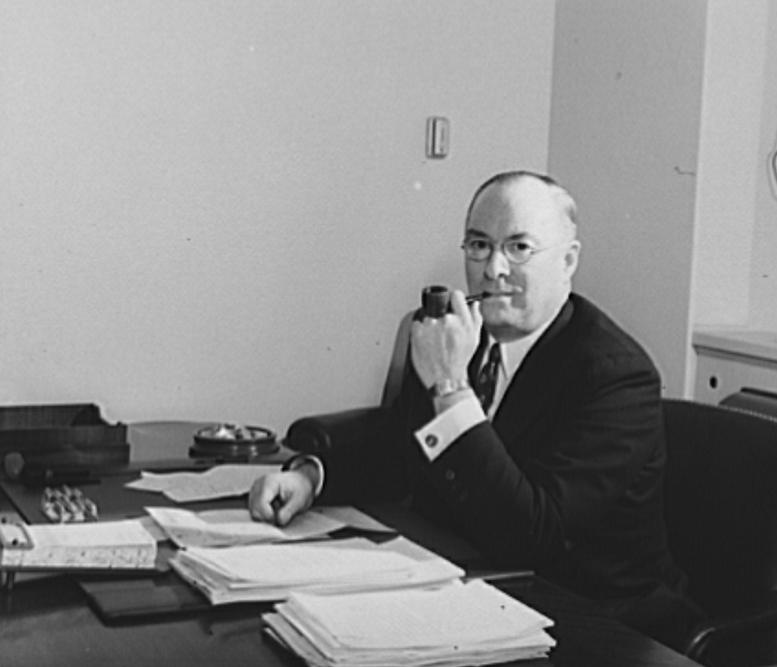 Donald Nelson (of Sears,
Roebuck & Co.) headed the War Production Board
(1942-1944)
Donald Nelson (of Sears,
Roebuck & Co.) headed the War Production Board
(1942-1944)
|
The
Federal government funded
the building of new industrial plants, encouraged industrial producers
to work
together (and thus had to suspend the antitrust laws outlawing just
such behavior) in order to optimize war production ... much to the
annoyance of FDR's New Deal supporters who still considered industrial
capitalism to be a vile
philosophy!
|
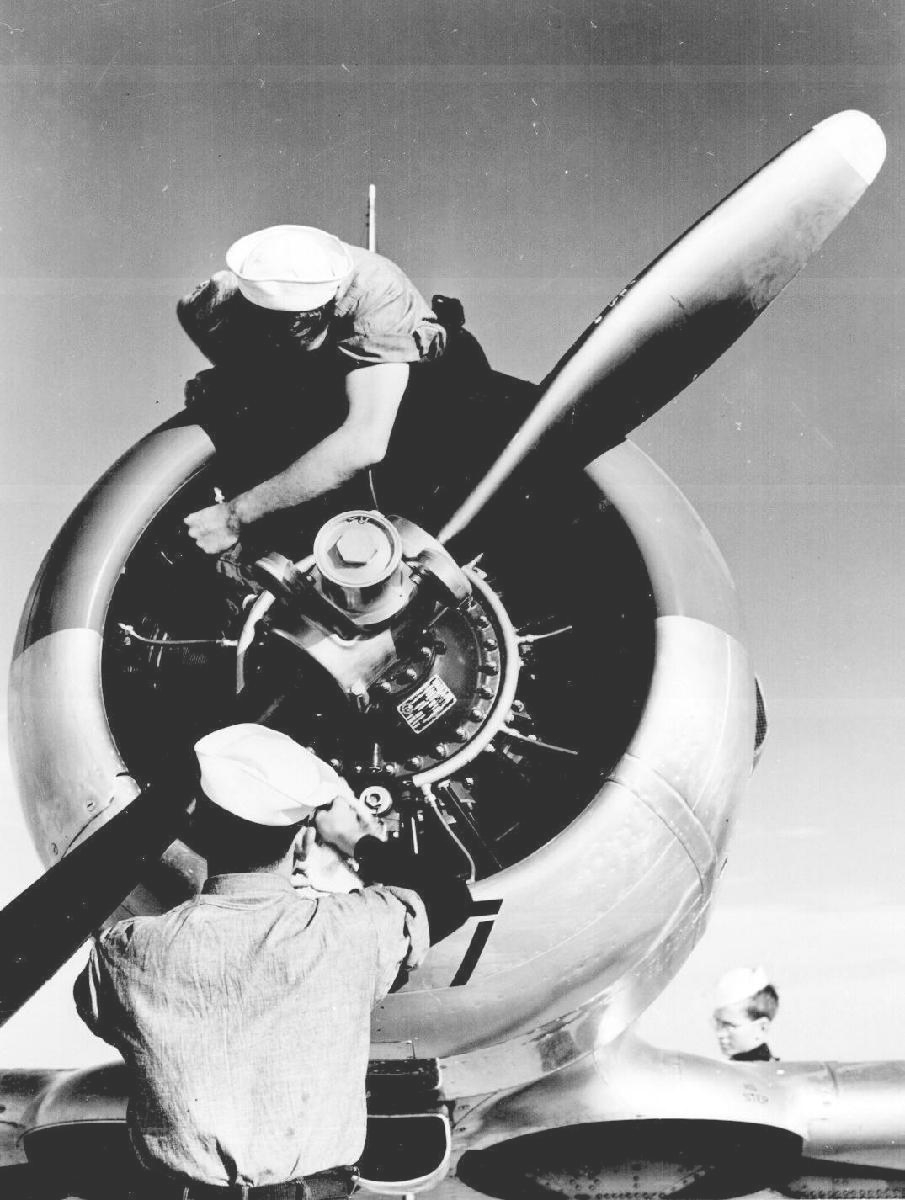
"Mechanics check engine of SNJ at Kingsville
Field, NATC, Corpus Christi, Texas."
Lt. Comdr. Charles Fenno Jacobs, November
1942.
National Archives
80-G-475186
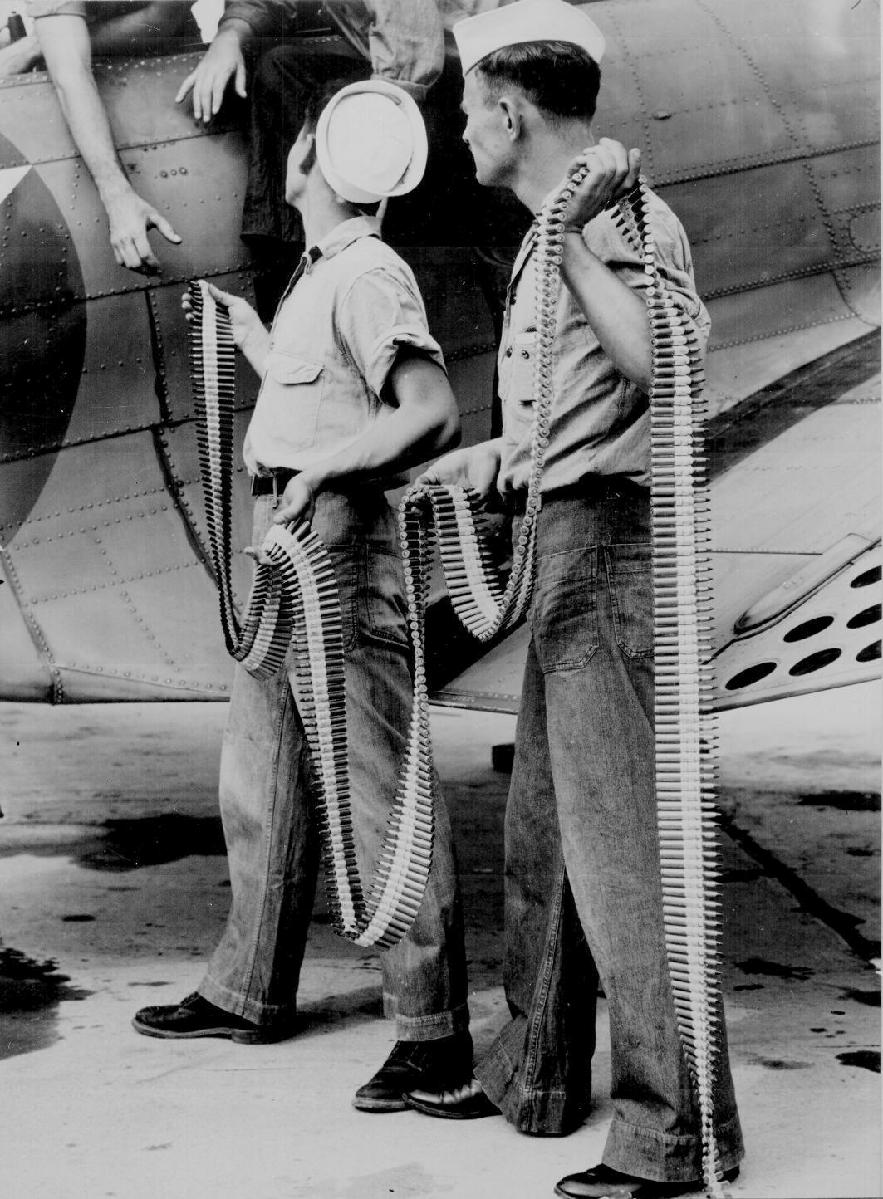
"Ordnancemen loading belted cartridges
into SBD-3 at NAS Norfolk, Va." September 1942
National Archives
80-G-472528
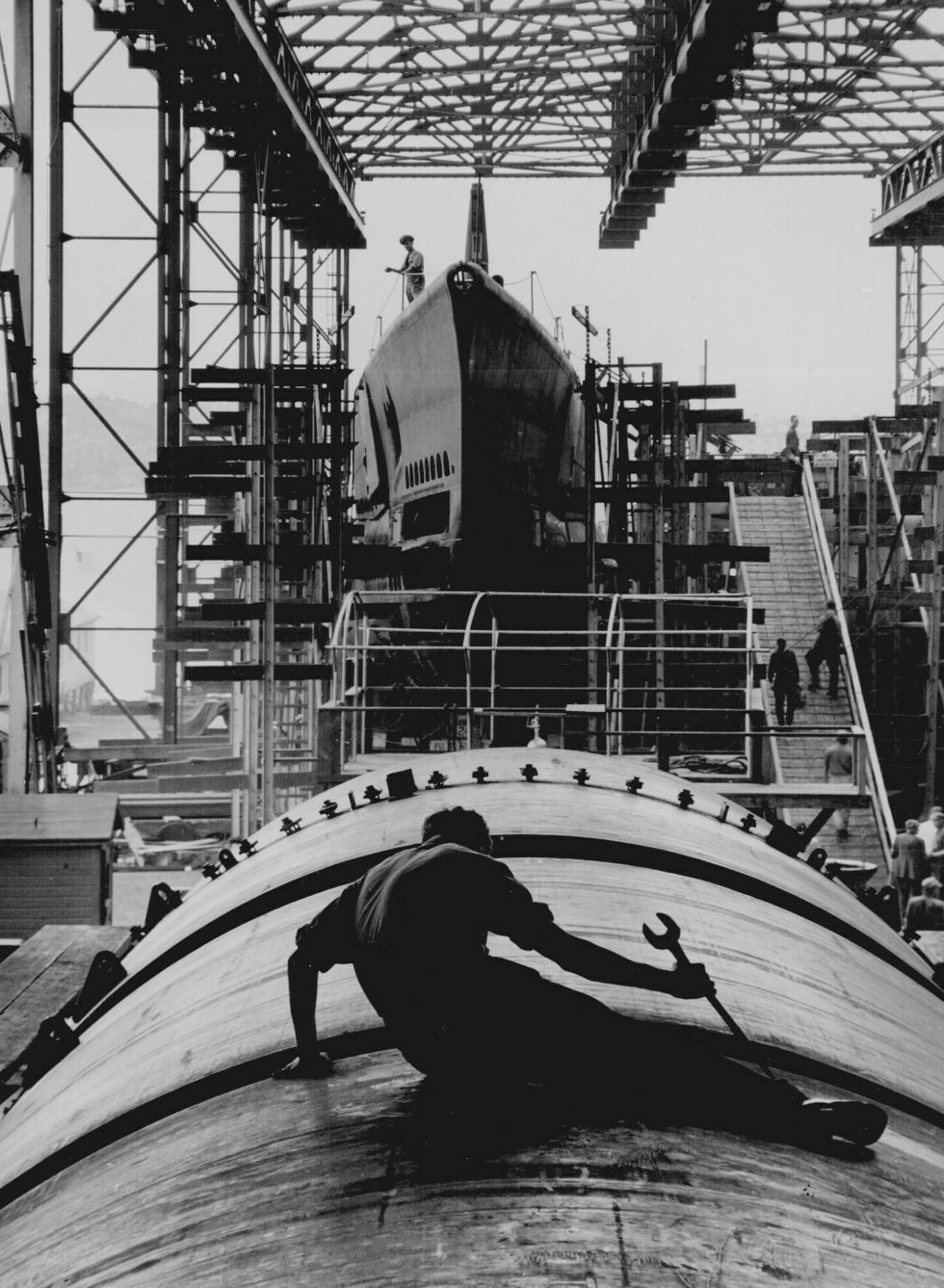
"Man working on hull of U.S. submarine
at Electric Boat Co., Groton, Conn."
Lt. Comdr. Charles Fenno Jacobs, August
1943.
National Archives
80-G-468517
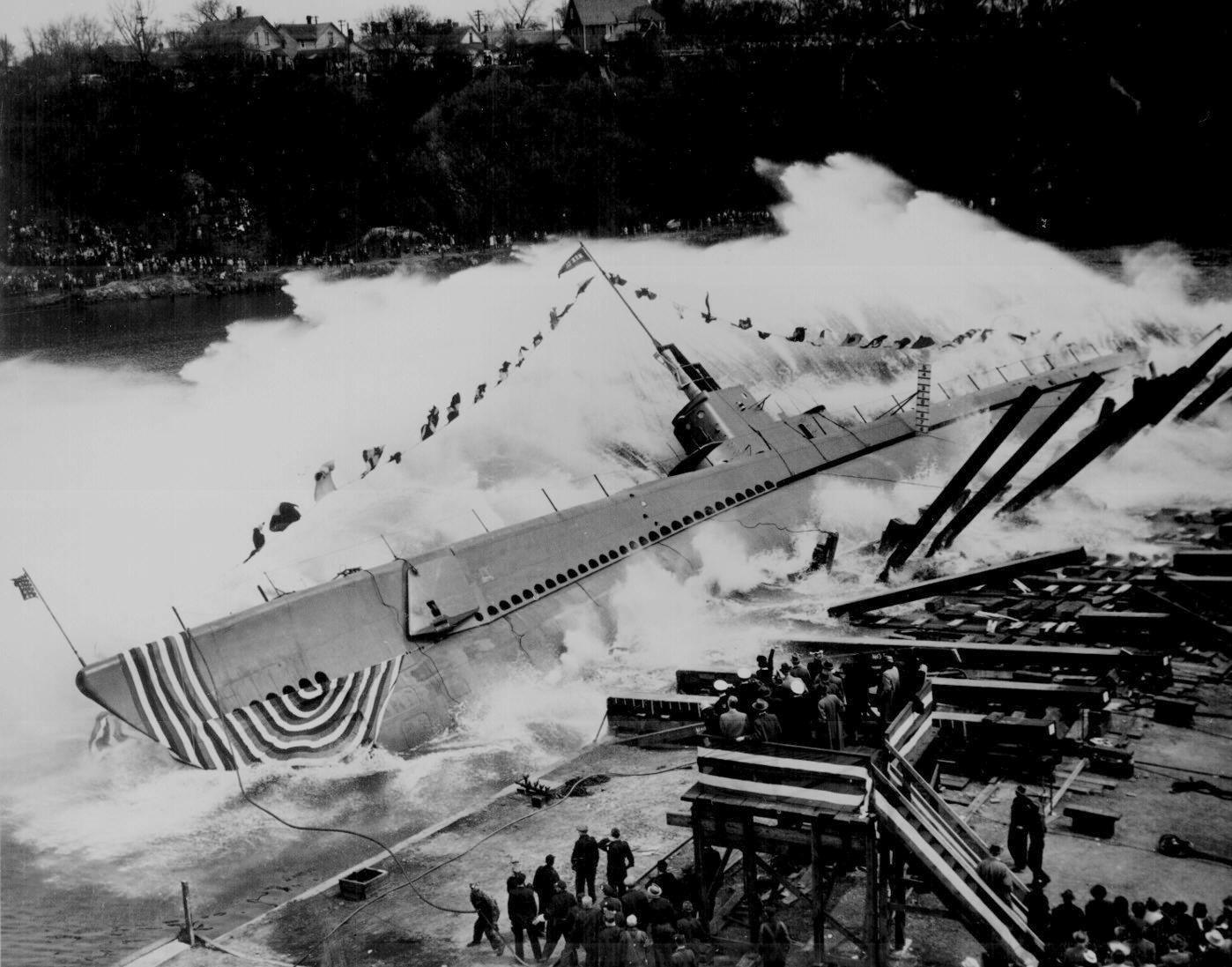
"Launching of USS ROBALO 9 May 1943,
at Manitowoc Shipbuilding Co., Manitowoc, Wis."
National Archives
80-G-68535
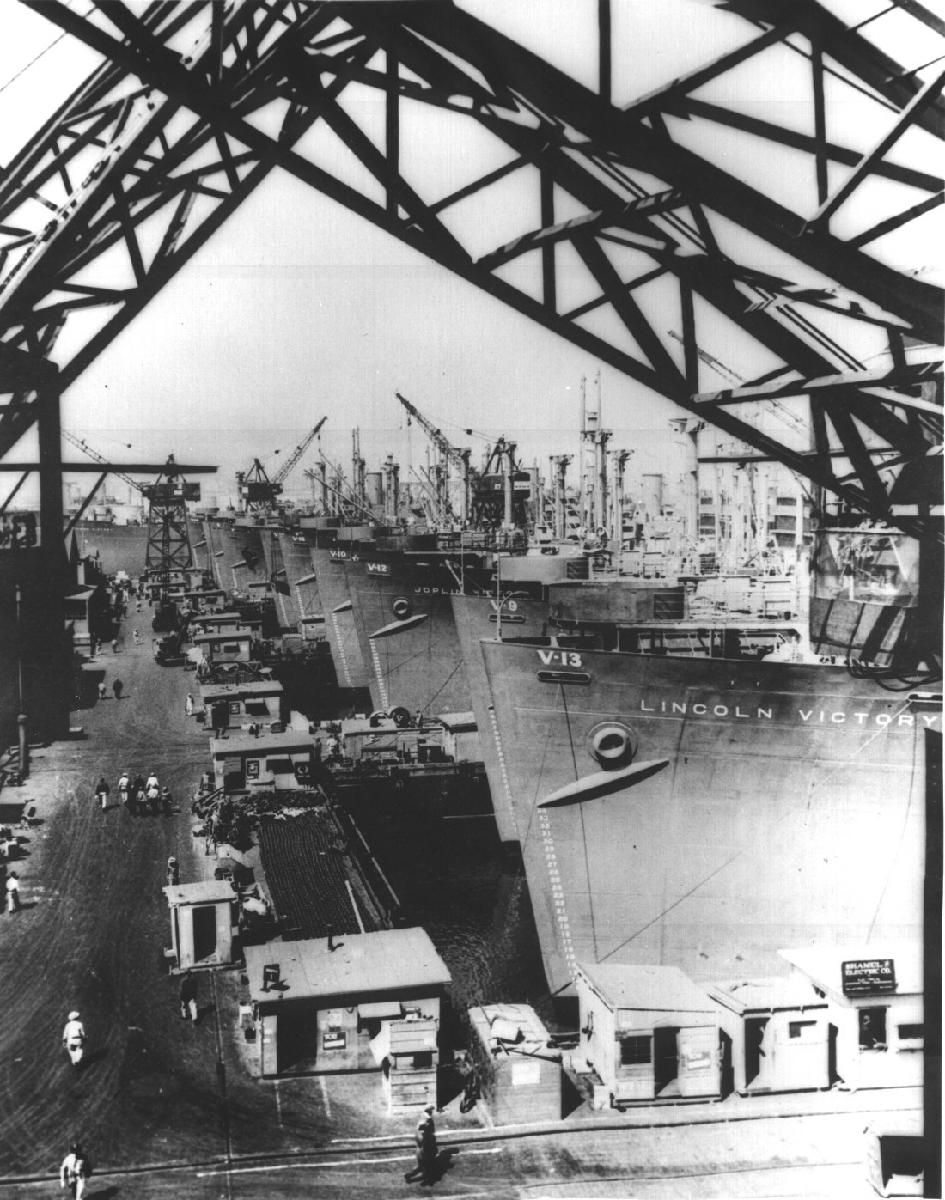
"Victory cargo ships are lined up at
a U.S. west coast shipyard for final outfitting before they are loaded with supplies for Navy
depots and advance bases in the Pacific." Ca. 1944
National Archives
208-YE-2B-7
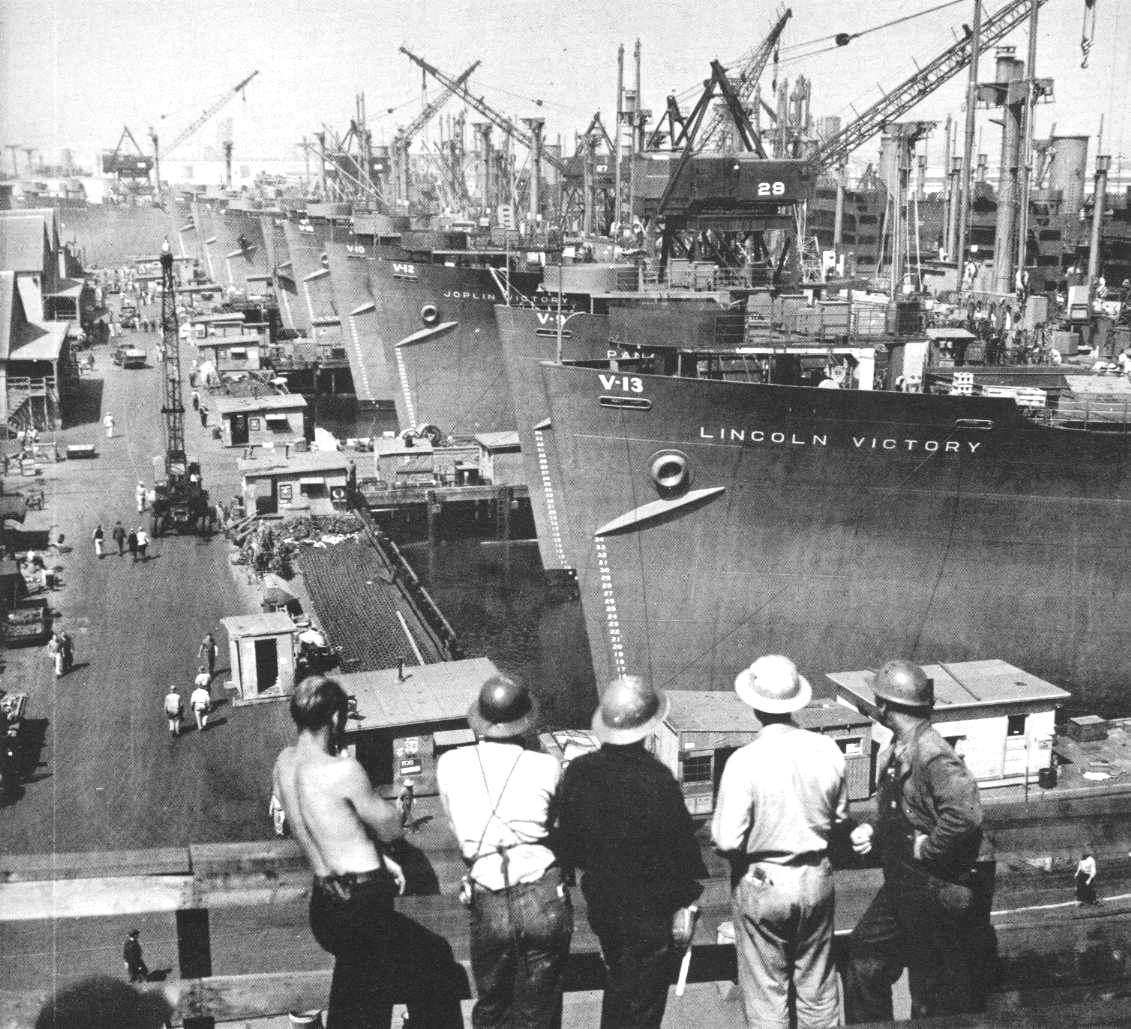
The construction of Victory
ships at the Calship Yards, Los Angeles (247 were built in the
first 212 days
of 1945)
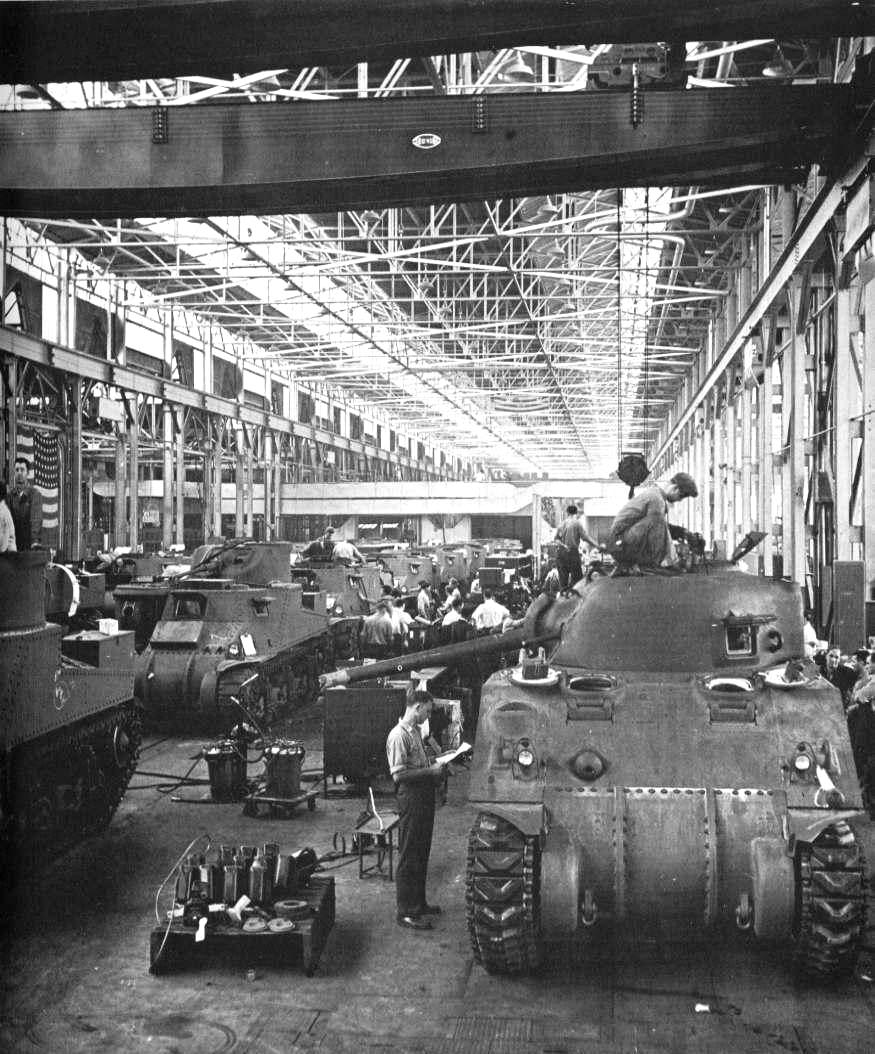
Chrysler tanks being checked
out as they come off the assemby line (Chrysler produced
25,507 in total)
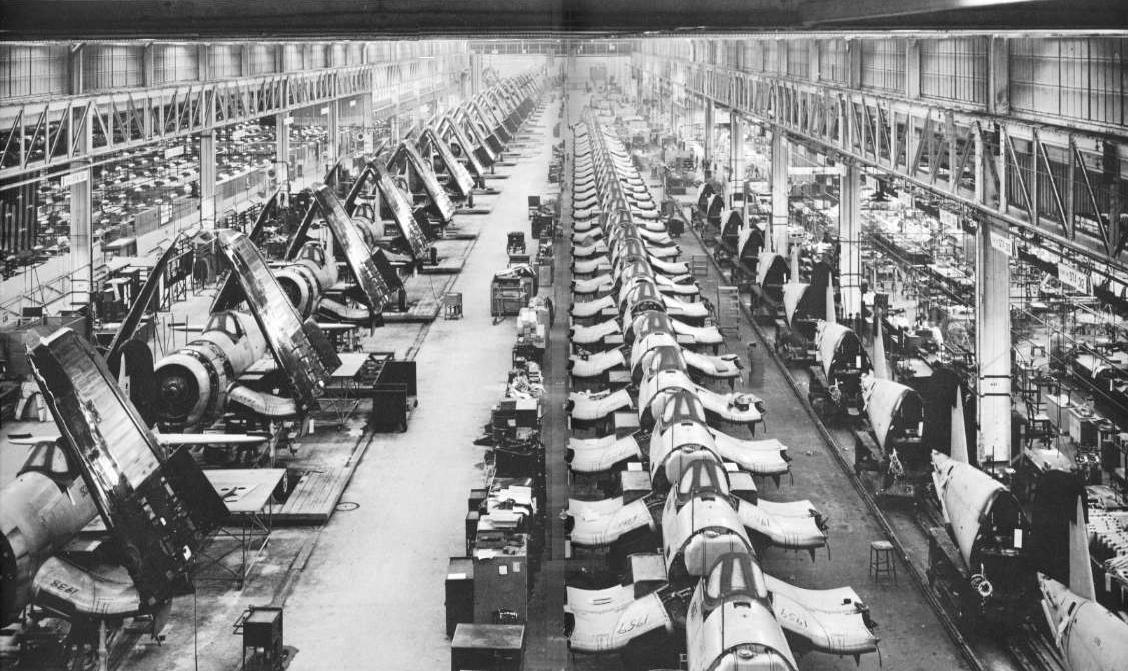
Some of the 6000 Corsair
fighter planes produced at this plant in Stratford, Connecticut
With
men drawn away to war
overseas, women are recruited to help make up the industrial labor shortage
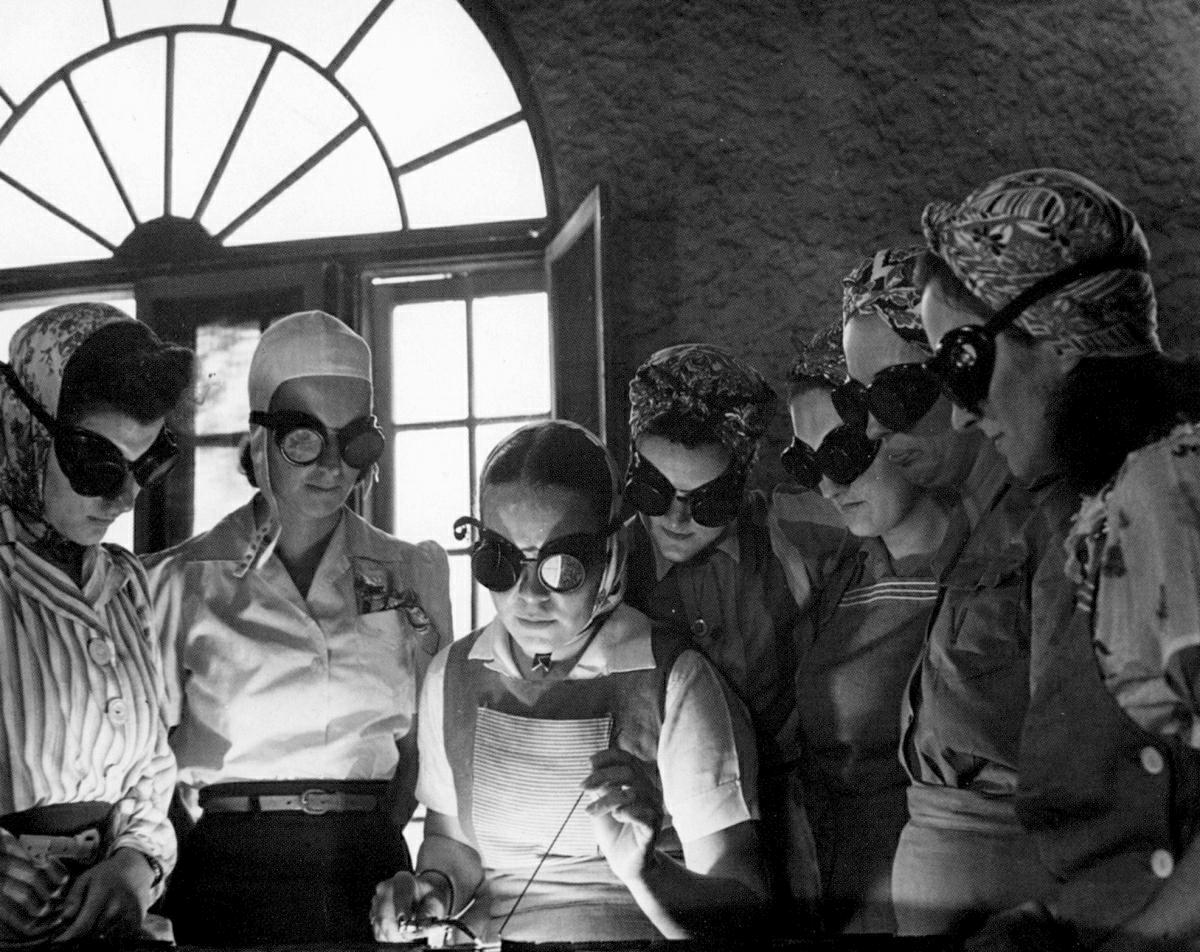
Secretaries, housewives,
women from all over central Florida are getting into vocational schools to learn
war work. Typical are these in the Daytona Beach branch of the Volusia county
vocational school – April 1942
National Archives
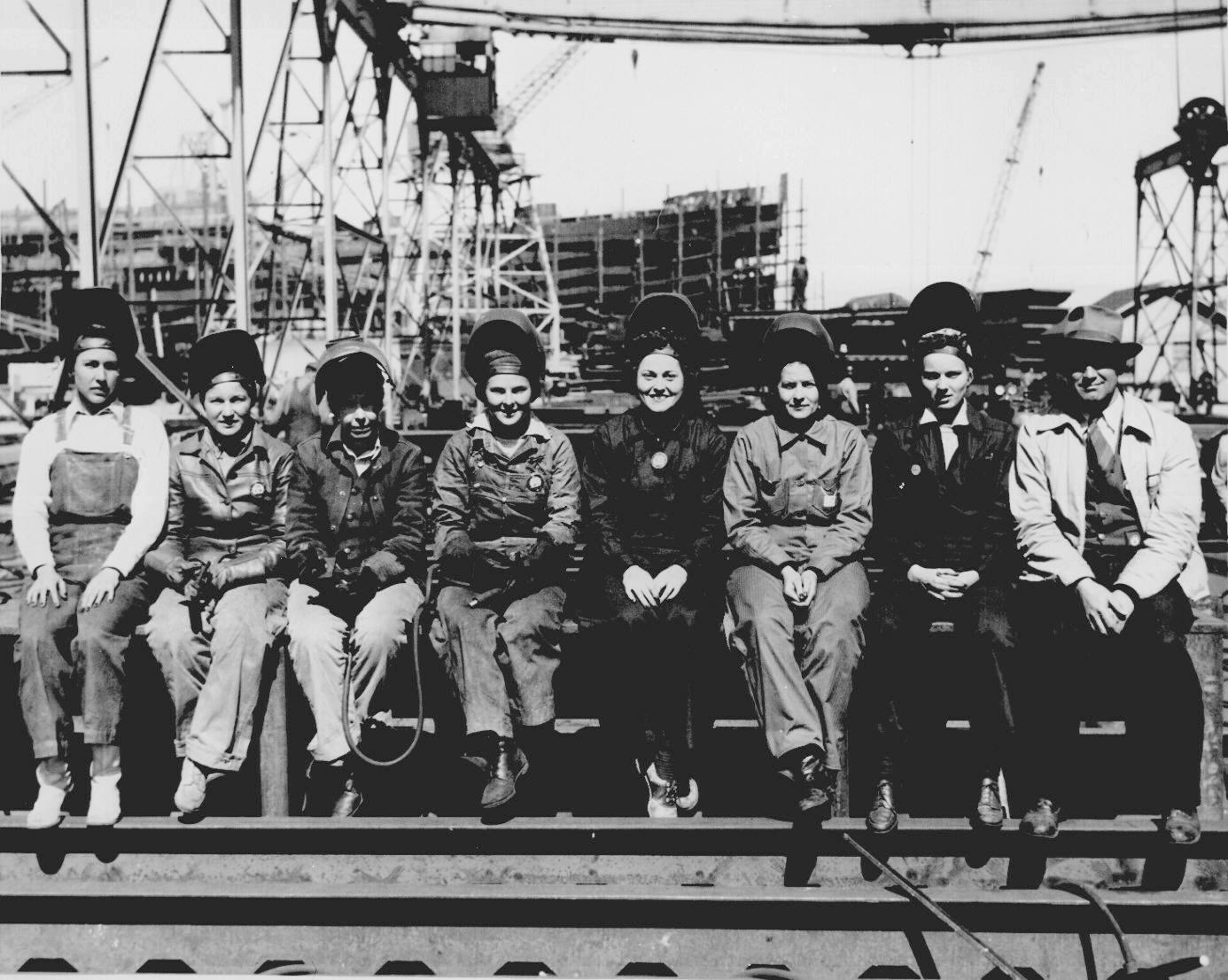
"Line up of some of women welders including
the women's welding champion of Ingalls [Shipbuilding Corp., Pascagoula, MS]."
Spencer Beebe, 1943.
National Archives
86-WWT-85-35
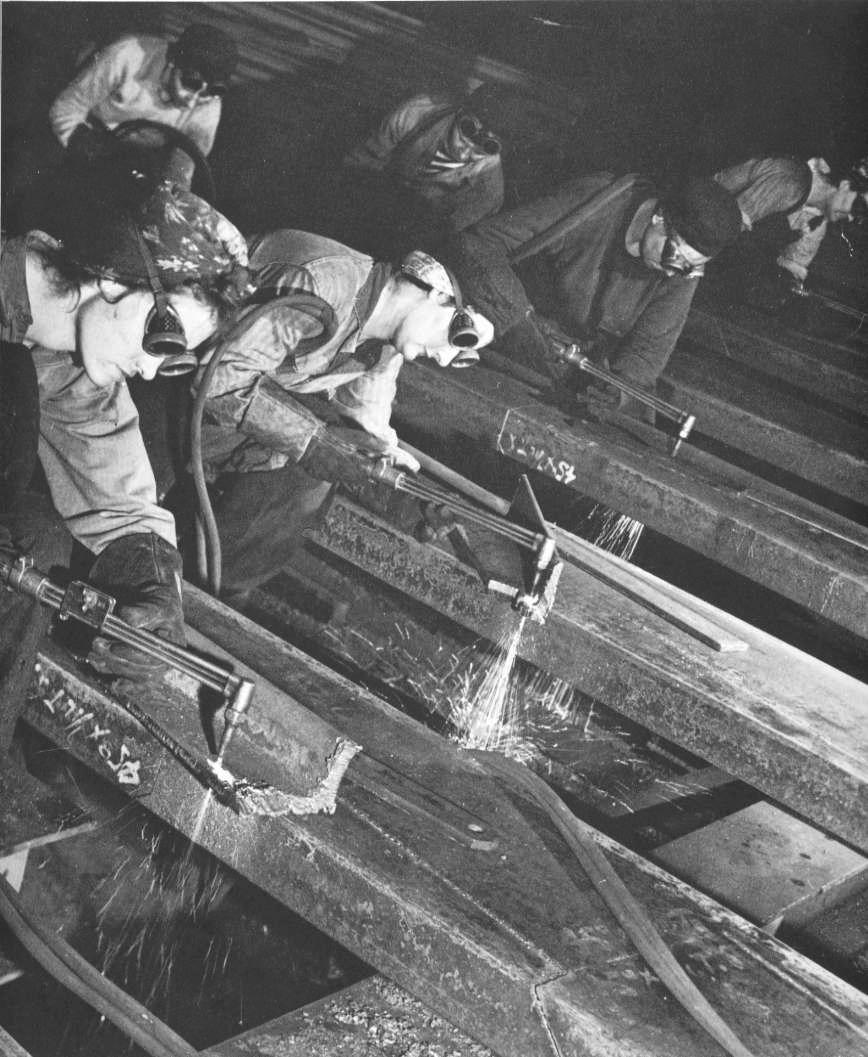
Women cutting armor
plating
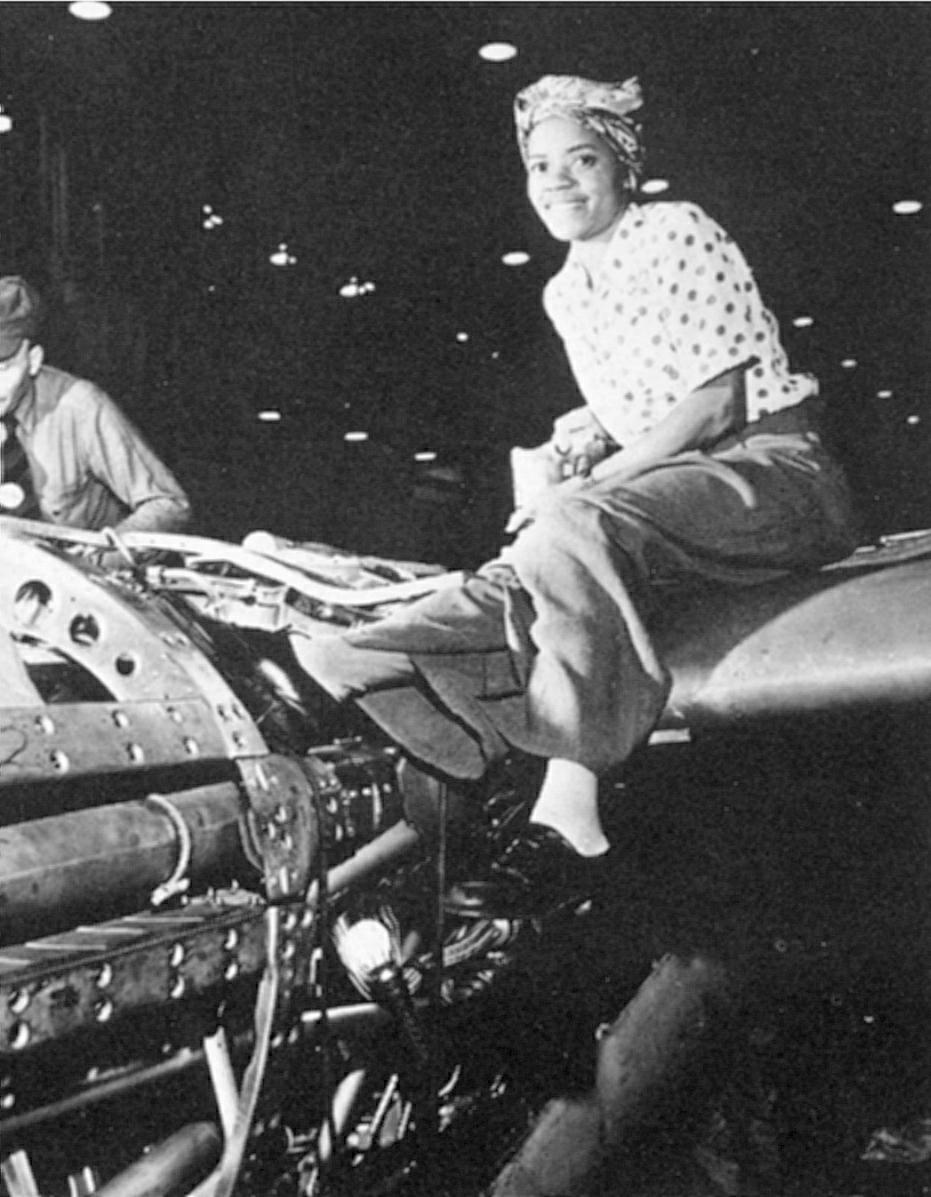
Female riveter at Lockheed
Aircraft Corp., Burbank, CA
National Archives
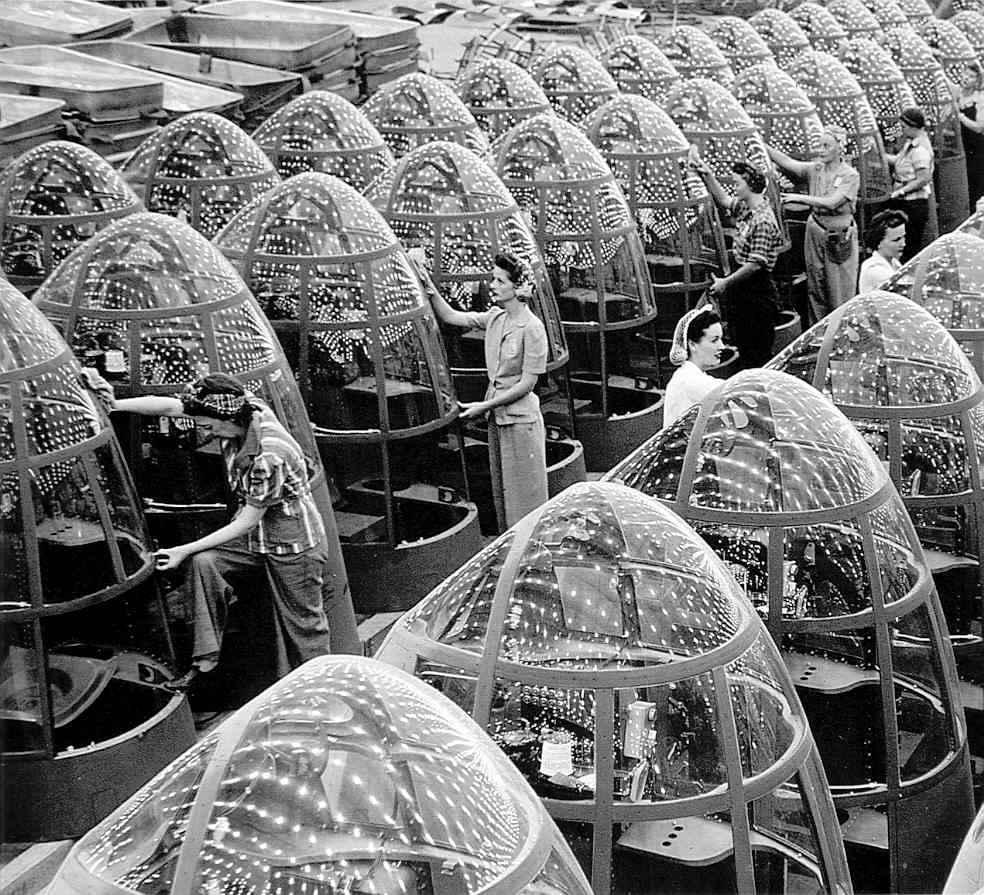
The Women Take Up the Task
of War Production (Bomber noses) at Douglas Aircraft, Long Beach, California
National Archives
A
number of women donned
the uniform of the WACs (Women's Auxiliary Corps)
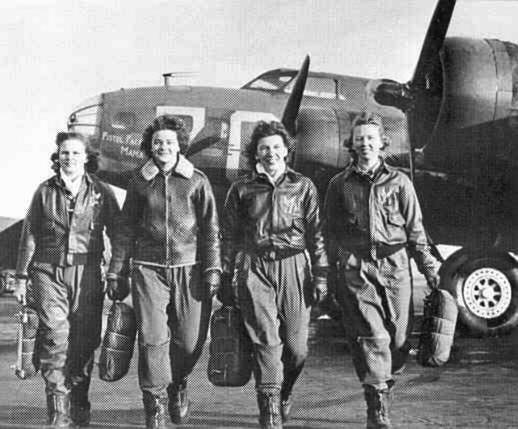 WACs delivering bombers to
England for action
WACs delivering bombers to
England for action
Smithsonian
Institution
THE WAR ON THE "HOME FRONT" |
|
Even
beyond that, all Americans were called to do their part on behalf of
the men fighting for their nation. Scrap of all sorts (paper, rubber
tires, tin cans, brass locks, scrap steel, even the metallic toothpaste
tubes) were collected for conversion into military material.
Furthermore food (which was being produced at a slower rate with so
many farm boys in uniform) was rationed, everything from meat, to
sugar, to can goods, virtually everything sold in a grocery store.
Money made no difference in the amount a family could buy, because all
families were under a point system of rationing, receiving on the basis
of family size just so many points in coupons, coupons that had to be
submitted with each purchase of food.
Integrity on the Home Front
But
by and large, the call to patriotic duty on the part of everyone was so
strong that relatively little cheating or corruption found its way into
American operations. But to make doubly sure, Missouri Senator Harry
Truman headed up a Congressional committee that examined closely the
accounting books of the industrial companies that were receiving
millions of dollars in government contracts for their war-materials
production. But amazingly things ran on a quite clean basis, especially
considering the vast amounts of money circulating because of war
production.
|
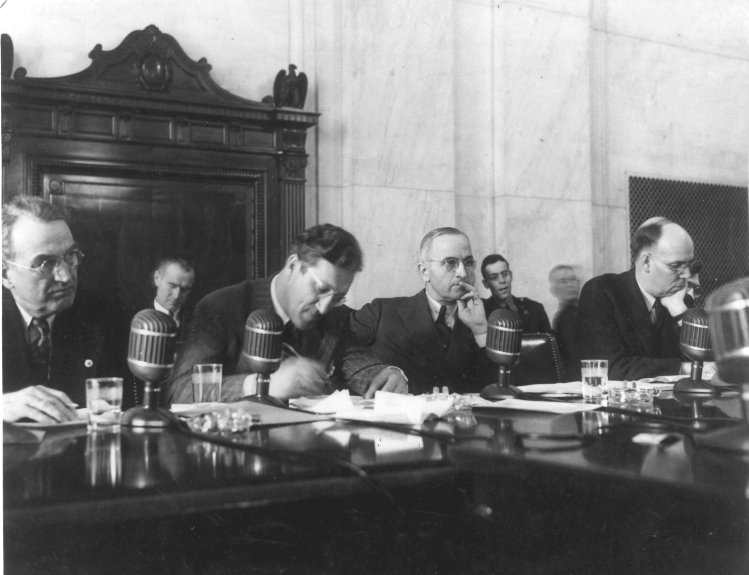 Thanks to the Senate's "Truman
Committee," there was a very close watch over the huge government funding to make
sure that it was used properly in advancing the American war industry.
Thanks to the Senate's "Truman
Committee," there was a very close watch over the huge government funding to make
sure that it was used properly in advancing the American war industry.
Miller Nichols Library -
University of Missouri – Kansas City.
One of the most amazing
developments
of the industrial ingenuity of American industry was the "Higgins boat," the plywood landing craft
(20,000 built) that would be invaluable in getting troops and supplies
from the ships to the beach
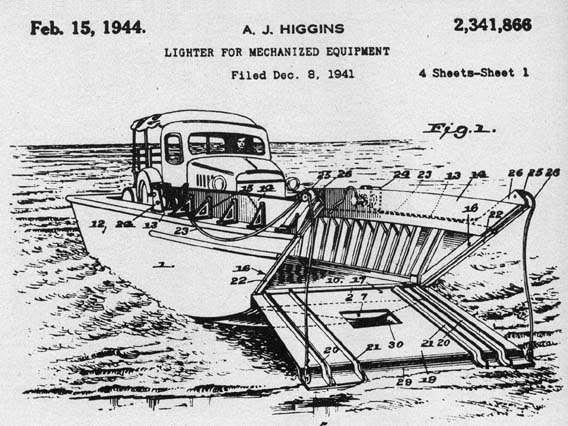
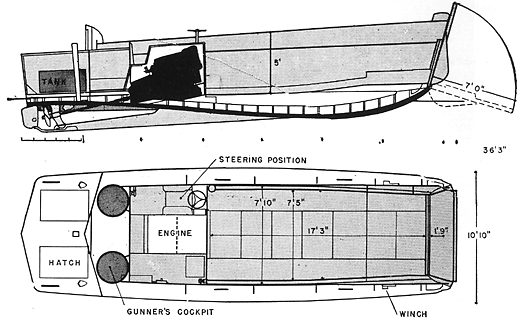
|
A.J.
(Andrew Jackson) Higgins
had to fight the bureaucratic resistance of the Bureau of Ships which refused to accept his design, favoring their own version
which proved unstable and prone to sinking. Thanks to the Truman
Committee, Higgins was finally given
the go-ahead to build the boats that Eisenhower would come to credit as a saving piece of the entire
war effort, without which the war would have been delayed ... if not even
unwinnable.
|
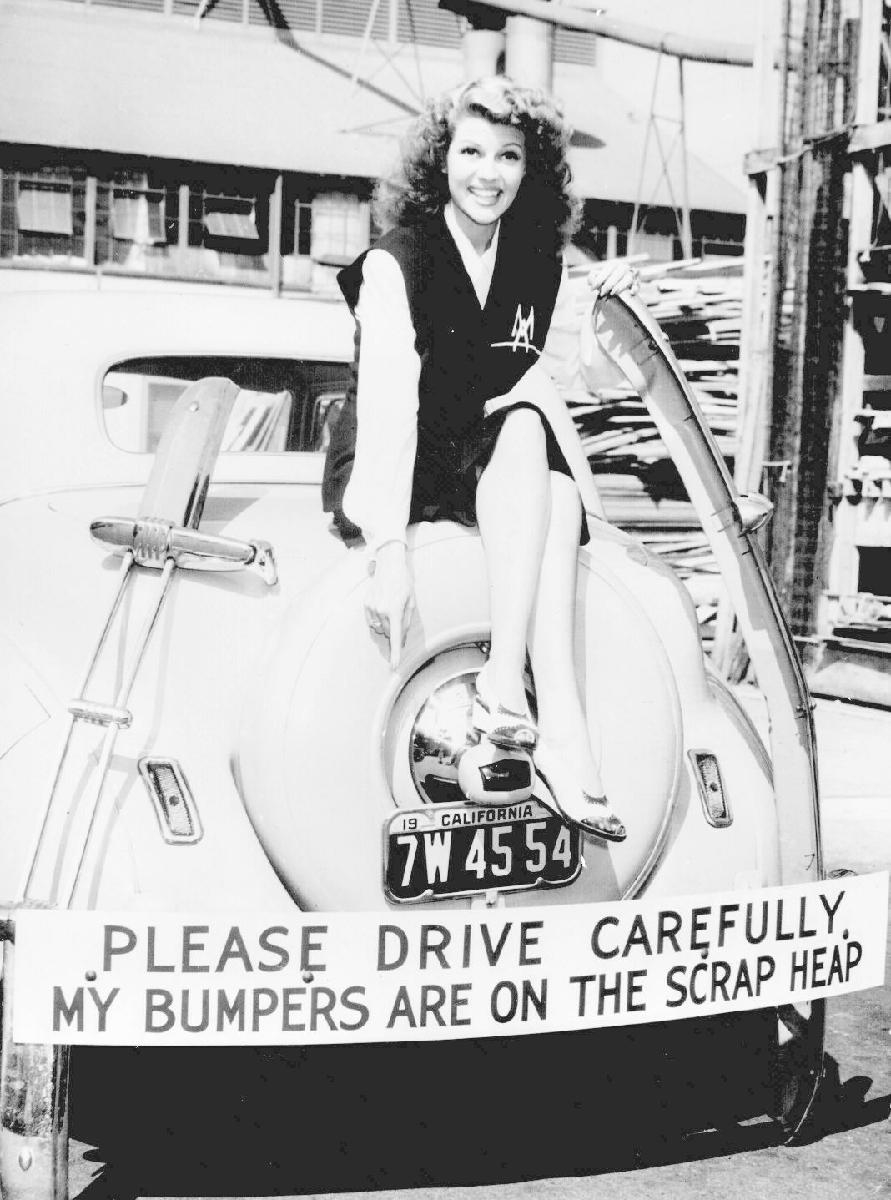
Movie star Rita Hayworth sacrificed
her bumpers for the duration. Besides setting an example by turning
in unessential metal car parts,
Miss Hayworth
has been active in selling
war bonds." 1942.
National Archives
208-PU-91B-5
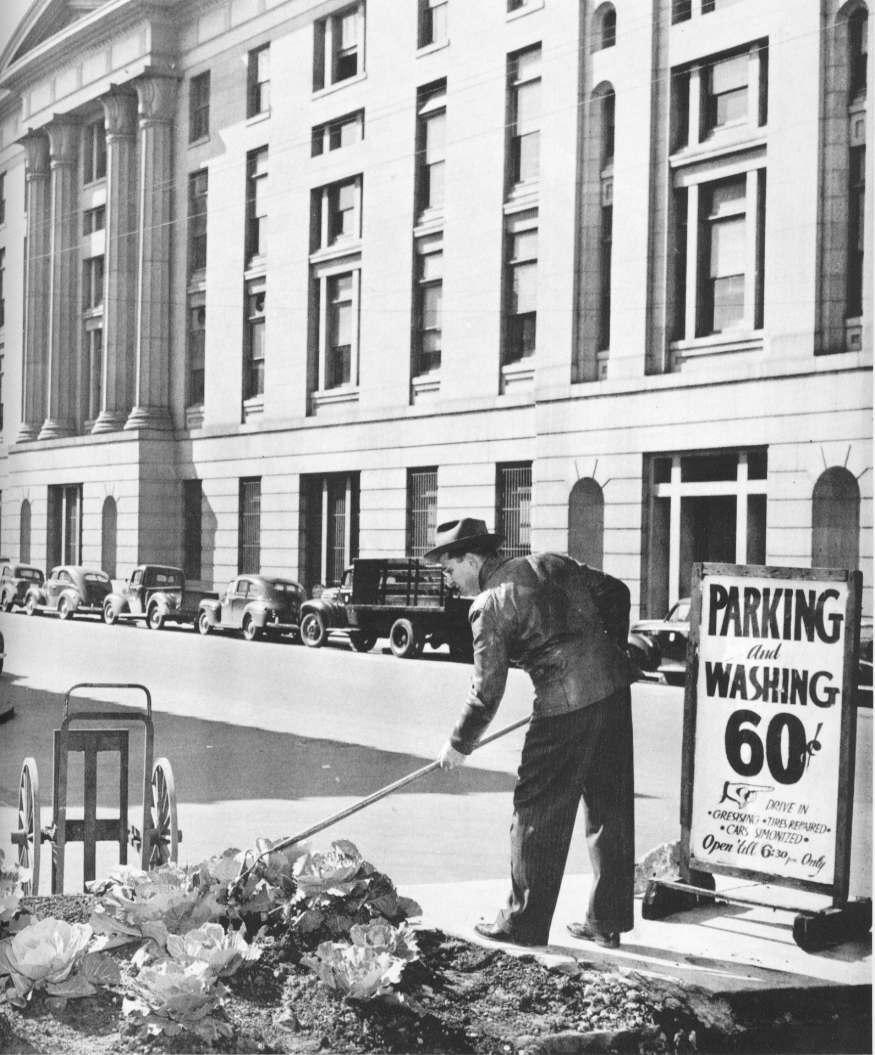
A Victory Garden in downtown
New Orleans
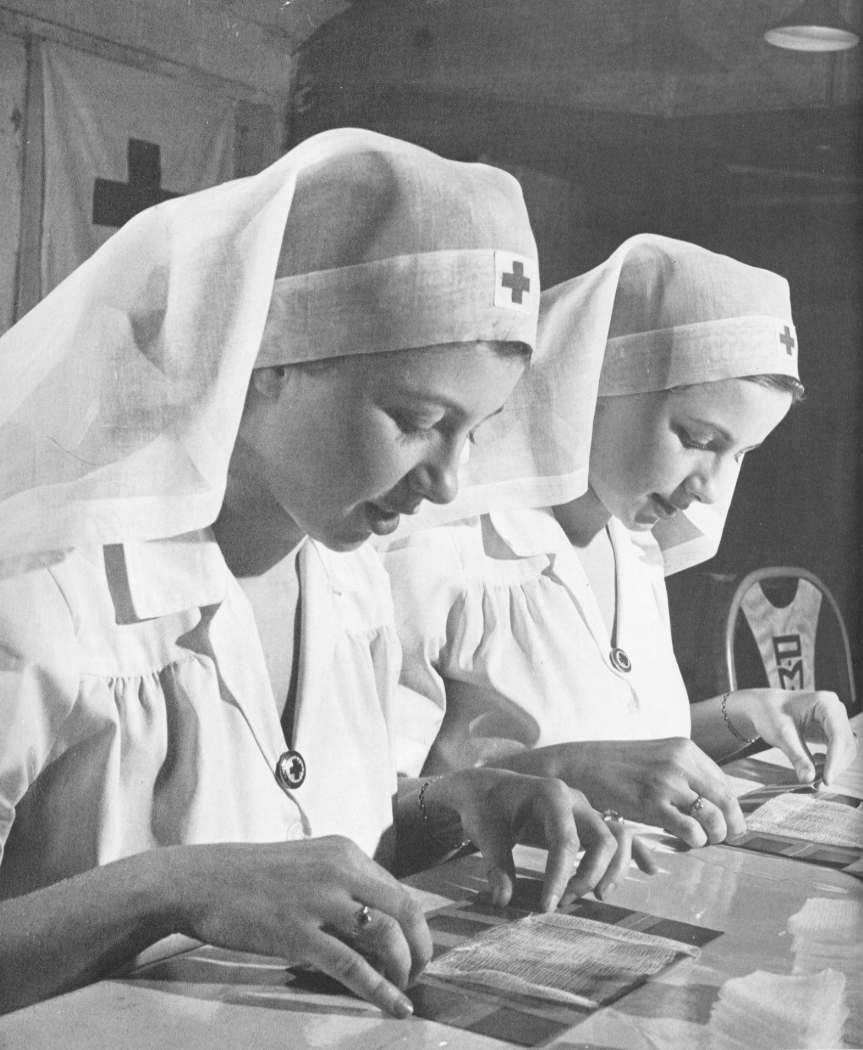
Twins serving as Red Cross
volunteers folding bandages in West Lafayette, Indiana
 Flattened tin cans being
collected as recycled war materiel.
Flattened tin cans being
collected as recycled war materiel.
Library of Congress
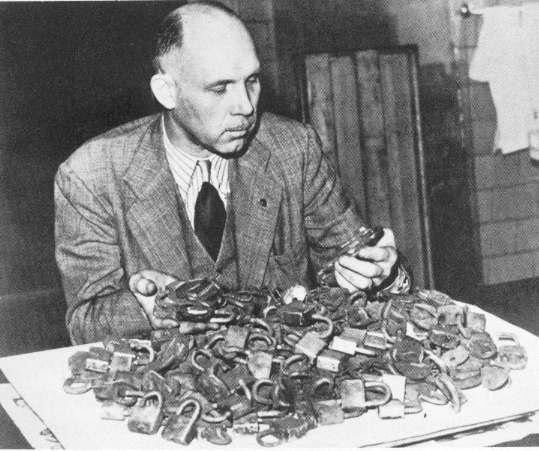 Padlocks being collected
for their bronze and steel components
Padlocks being collected
for their bronze and steel components
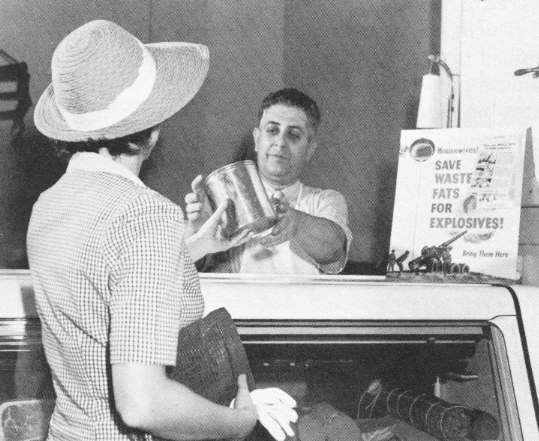 A woman giving bacon grease
for use in making ammunition
A woman giving bacon grease
for use in making ammunition
Library of Congress
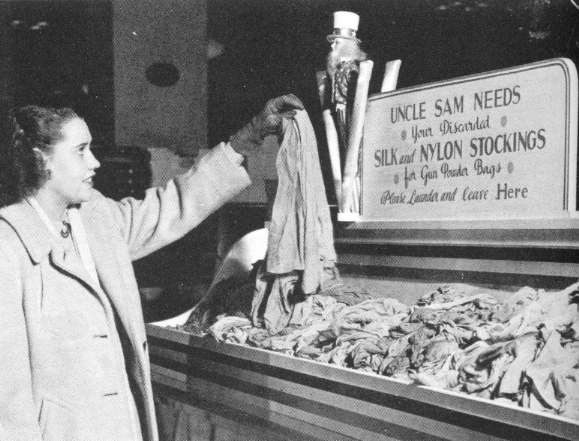 A woman passing on her nylon
stockings for use in powder bags
A woman passing on her nylon
stockings for use in powder bags
Library of Congress
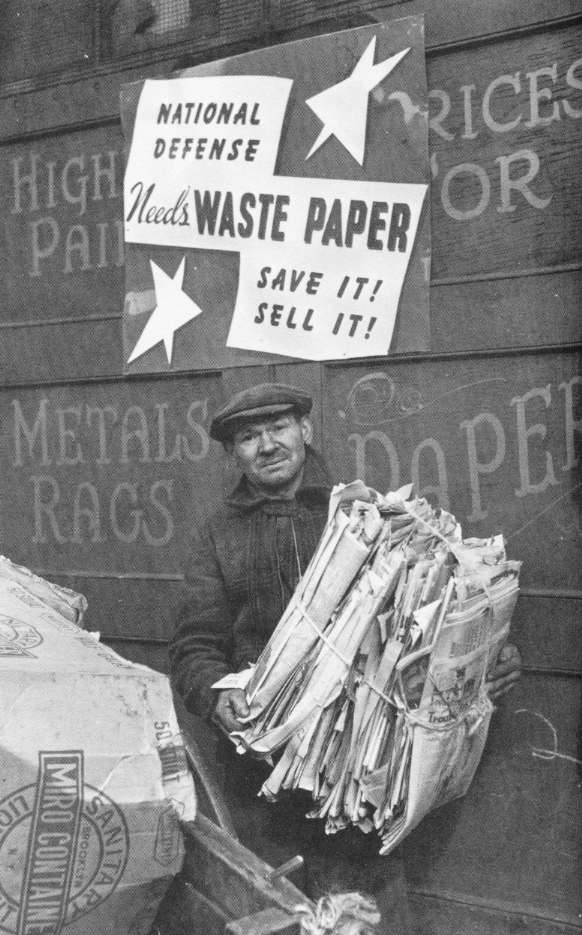
Newspapers being collected
for use in making packing boxes
Library of Congress
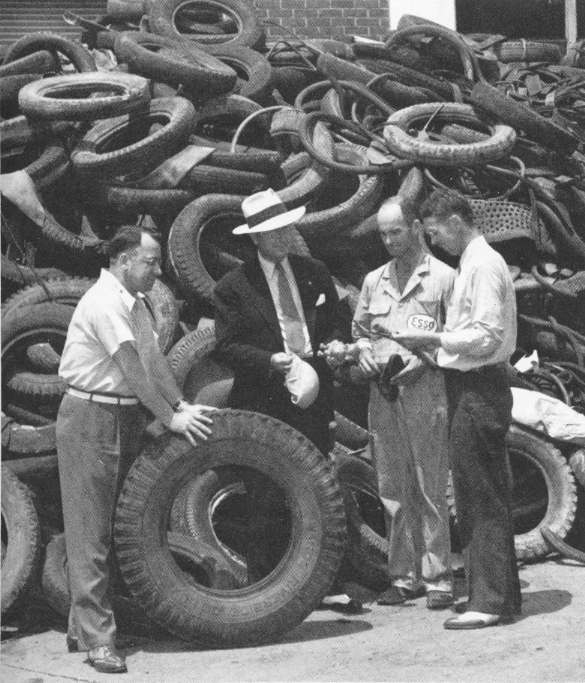 Worn-out tires being collected
as scrap rubber
Worn-out tires being collected
as scrap rubber
State Department of Archives
and History, Raleigh, N.C.
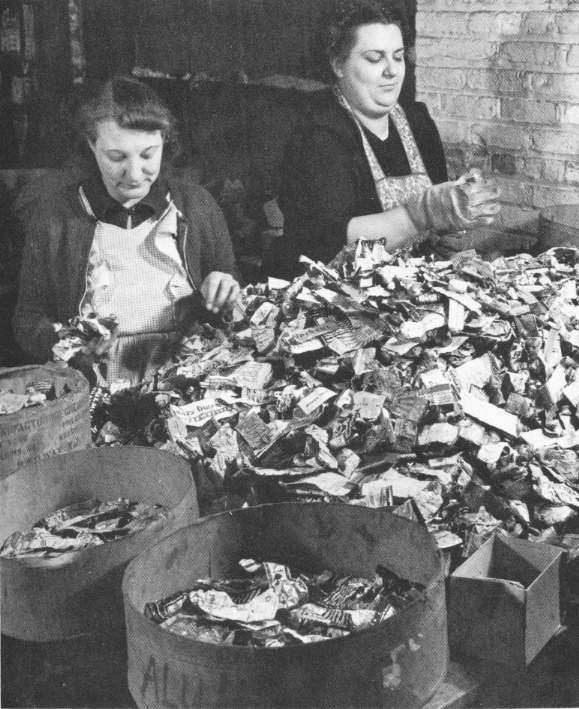 Toothpaste tubes being collected
for their metal content
Toothpaste tubes being collected
for their metal content
Library of Congress
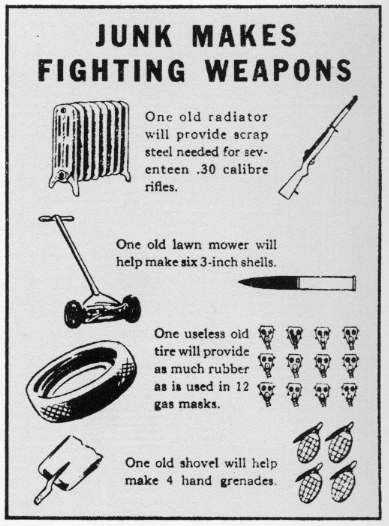 A poster explaining the many
uses of common household scrap
A poster explaining the many
uses of common household scrap
"Rationing" helped direct American wealth away from personal use ... to wartime use
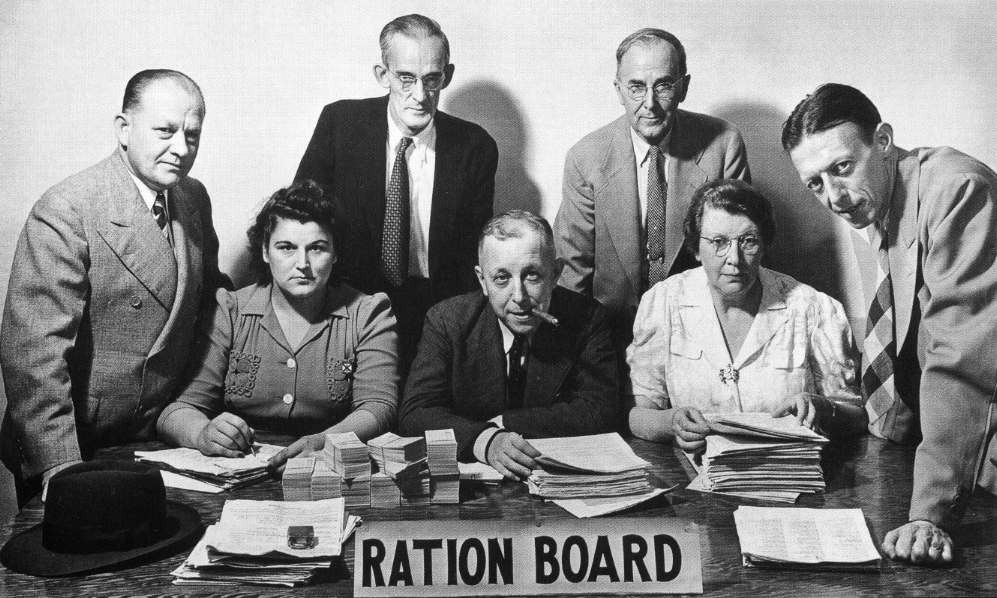
The federal Ration Board
in Bristol, Connecticut
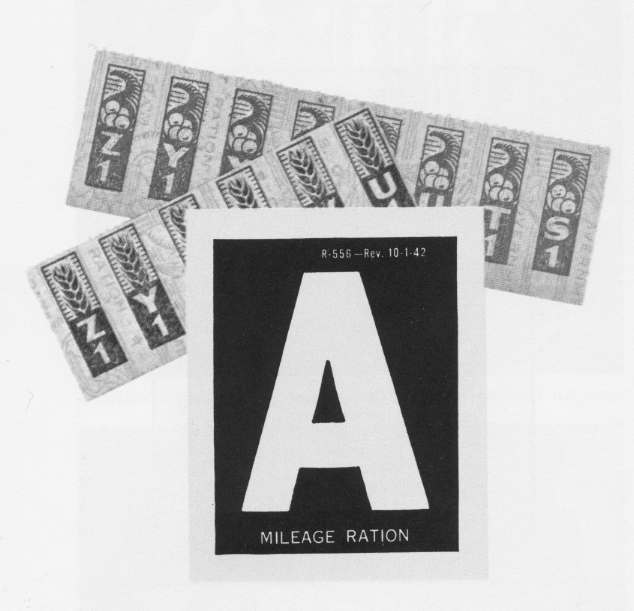 Ration stamps
Ration stamps
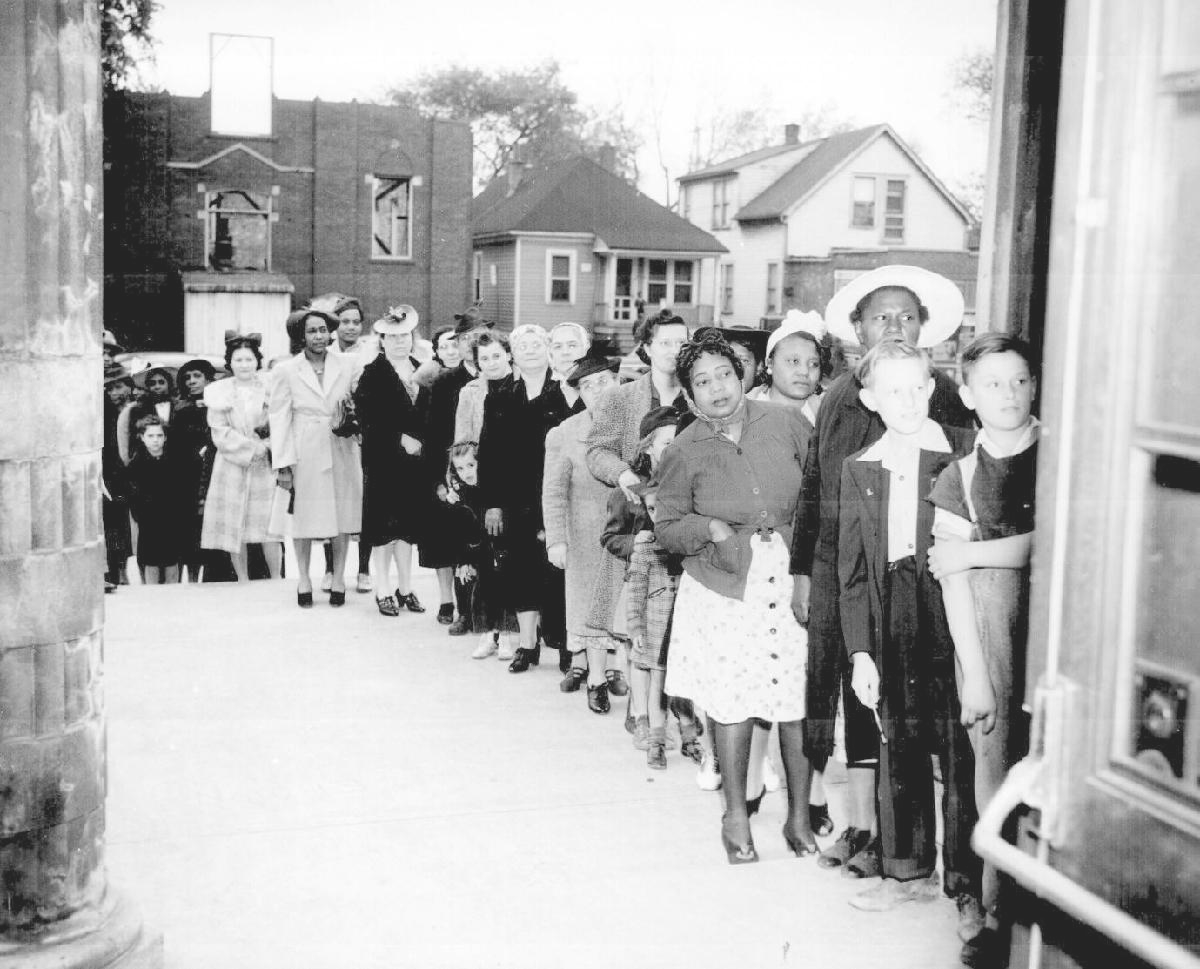
Sugar rationing.
National Archives
208-AA-322I-2

The point system for meat
rationing
Library of Congress
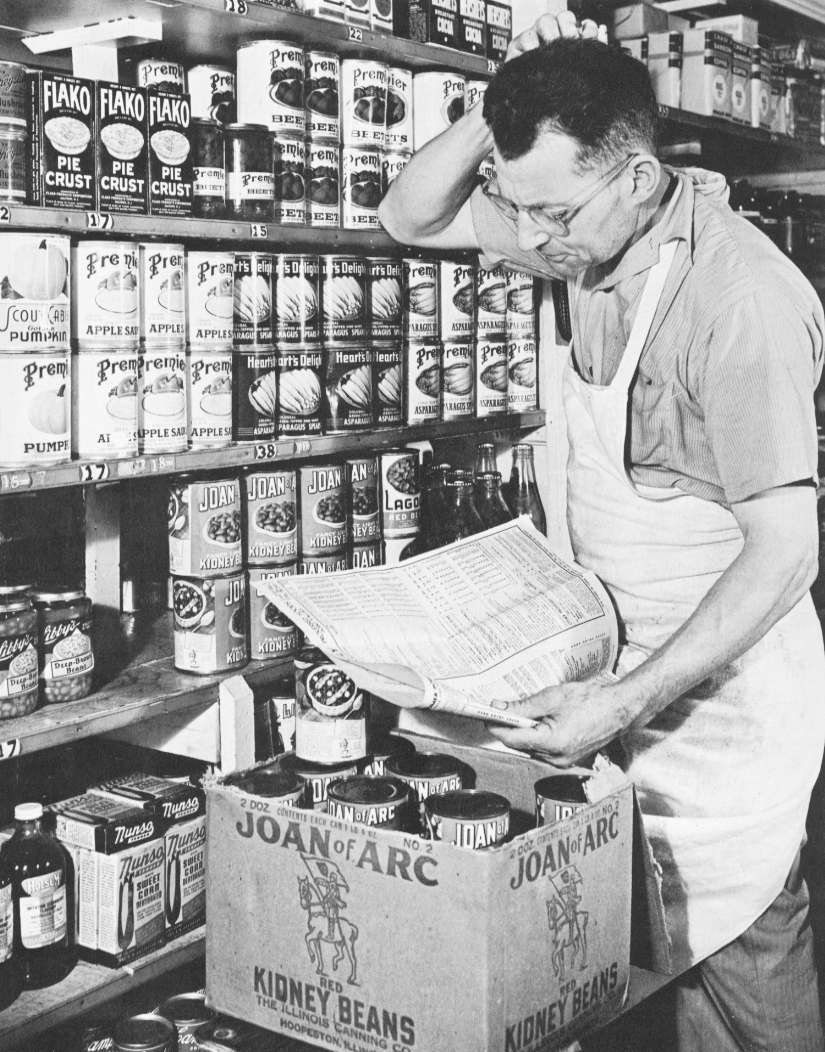
A grocer trying to figure
out the point system
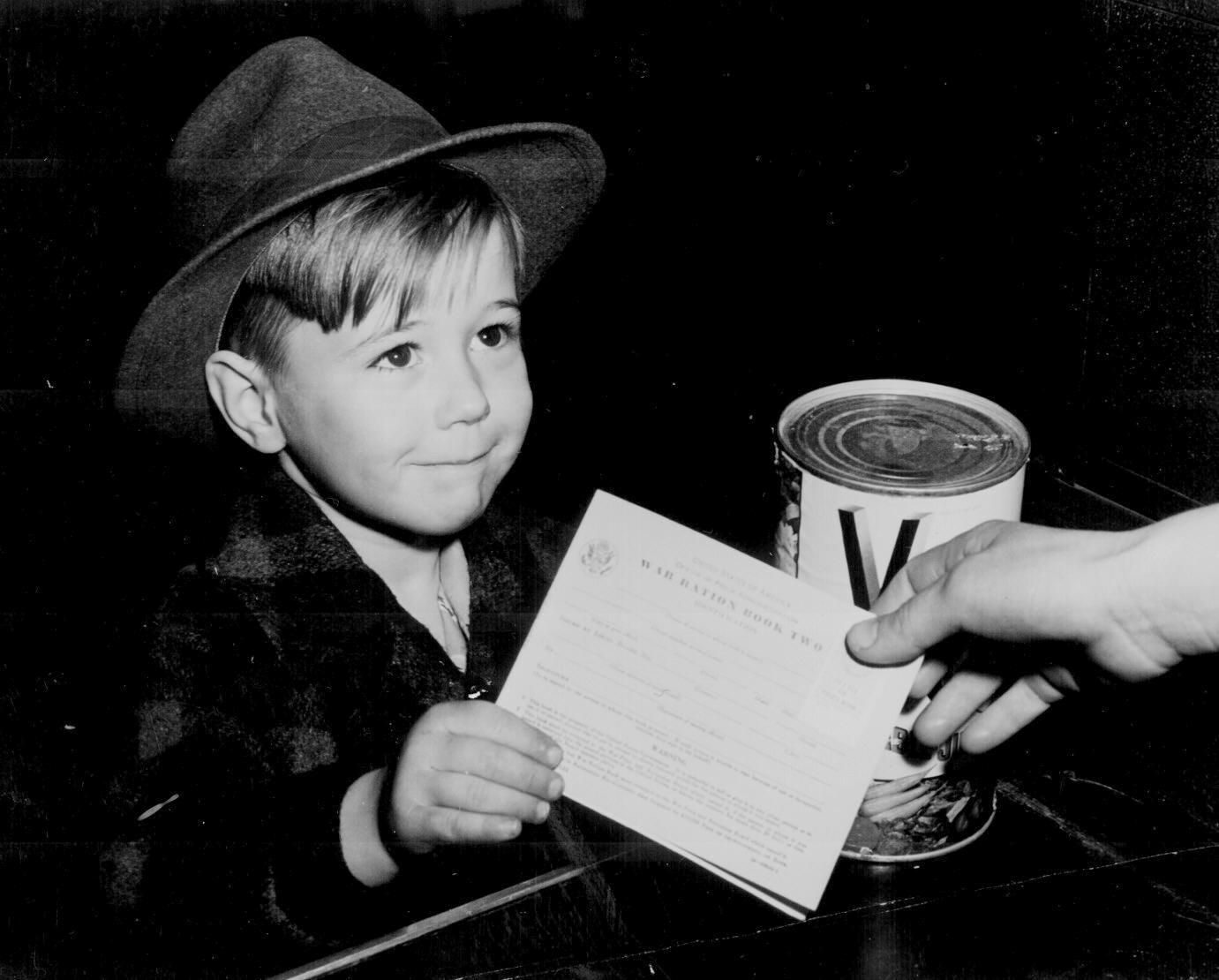
"An eager school boy gets his first
experience in using War Ration Book Two. With many parents engaged in war work,
children are being taught the facts of rationing for helping out
in family marketing." Alfred Palmer, February 1943
National Archives
208-AA-322H-1
Occasionally the war comes all the way up to America's doorstep
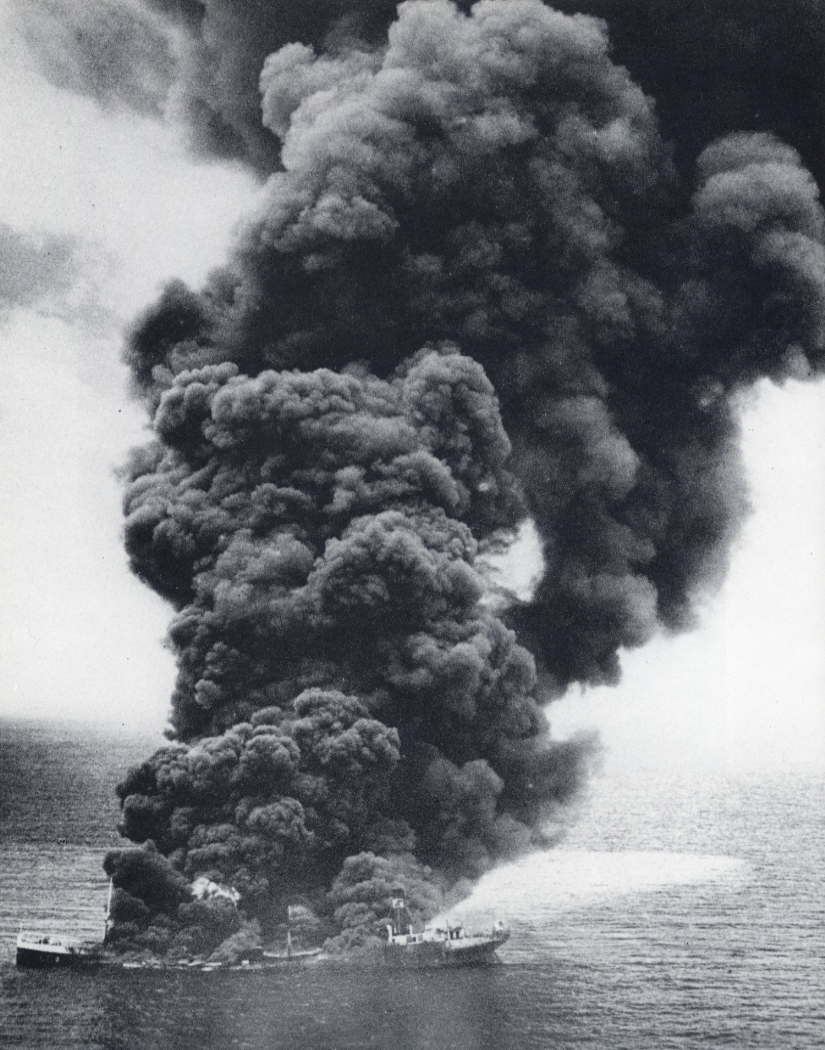
A US tanker hit by a German
submarine off the Florida coast – 1943
United
States Army Air Force
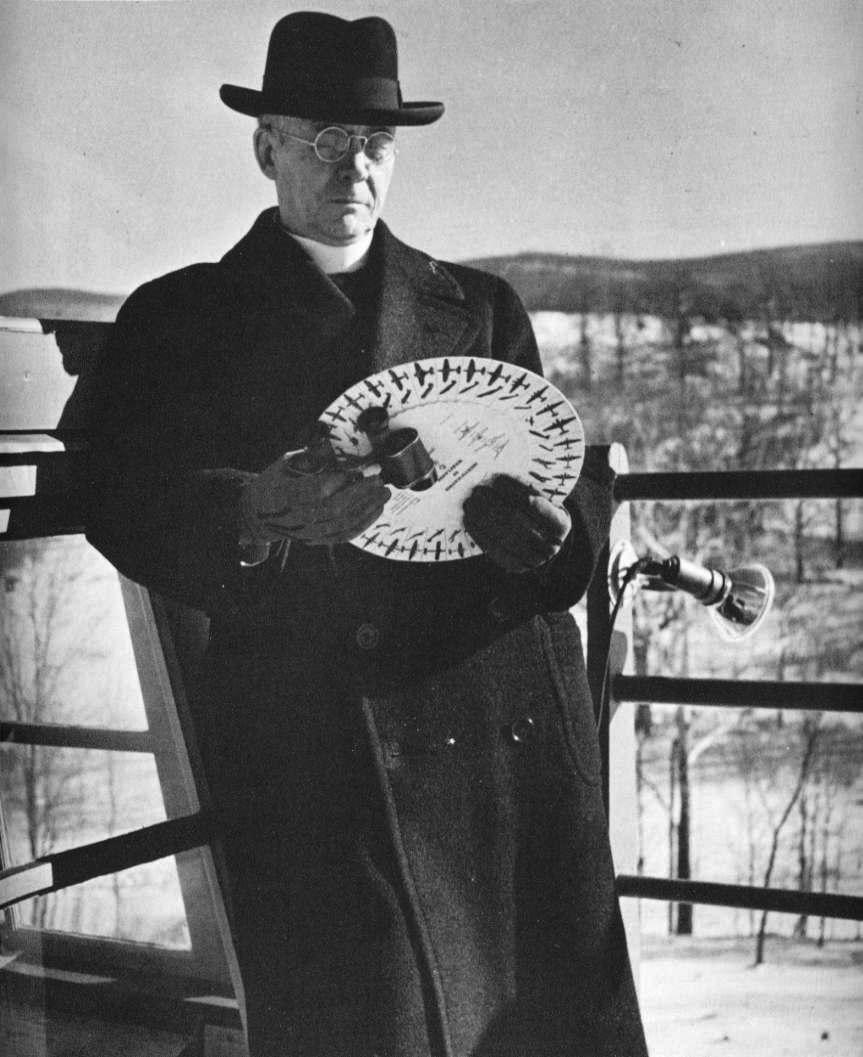
An air spotter at his post
in Kent, Connecticut
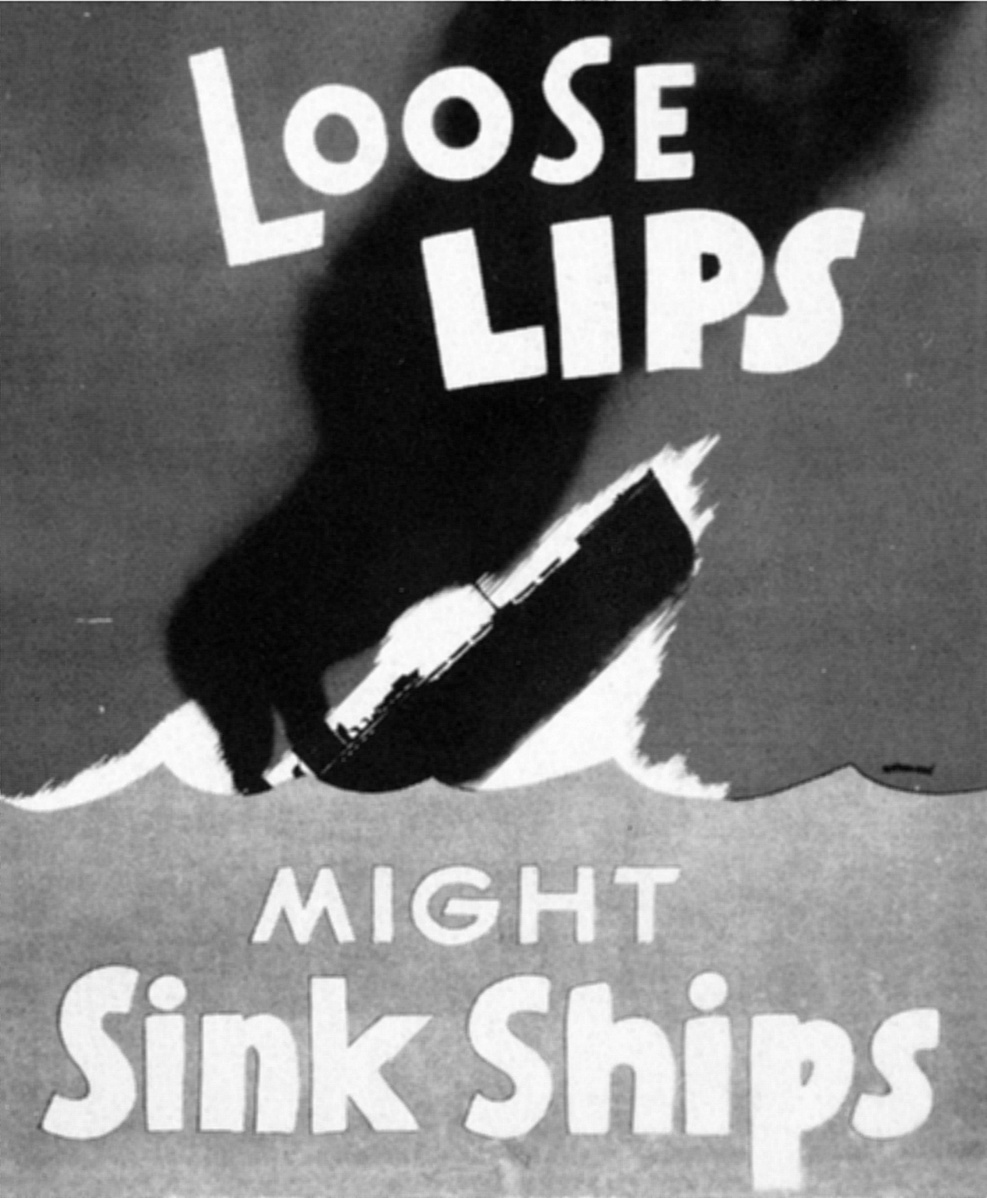 Loose Lips might sink
ships.
Loose Lips might sink
ships.
National Archives
Japanese "internment"
One sad chapter in the story of America's wartime
government-society relationship was the 1942 Executive Order 9066
ordering 110,000 civilians of Japanese descent (included in that number
were 71,000 actual American citizens) living along America's West Coast
(principally California) to be sent to internment camps, huge camps of
bleak and depressing barracks-style housing – where these ethnically
Japanese families could be contained. The program was justified on the
basis that the Japanese had acted so treacherously in their attack on
Hawaii, that fear became widespread that Japanese-Americans might
secretly be part of a "Fifth Column" at home (the Fifth Column refers
to the large communities of German residents in neighboring countries
which worked closely with Hitler's Nazis by purposefully created chaos
in those lands so as to make the Nazi conquest of Germany's neighbors
all the easier).
The move is all the more shameful in the
targeting of Japanese-Americans, when German-Americans and
Italian-Americans were not only not interned, but served quite readily
in the US military in fighting Germany and Italy. Actually, some
Japanese-Americans would enter US military service. But in general, the
internment of the Japanese-Americans was widespread, causing these
American citizens to lose their homes and businesses permanently. But
the Japanese were amazingly graceful in the face of this huge betrayal
of American democratic (even Christian) norms.
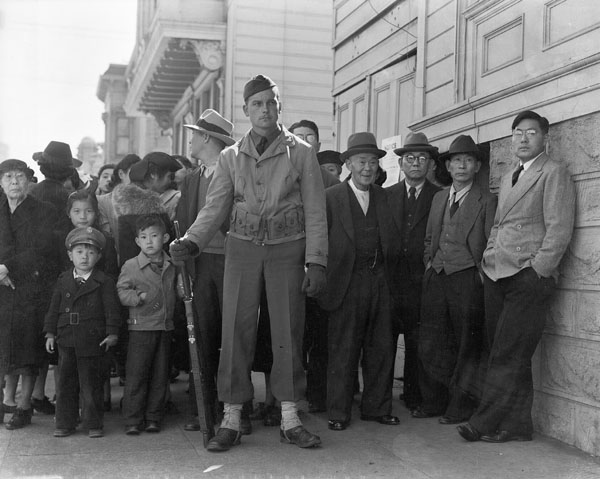
"A crowd of onlookers on
the first day of evacuation from the Japanese quarter in San Francisco, who themselves
will be evacuated within three days." By Dorothea Lange, San Francisco,
California, April 1942
National Archives
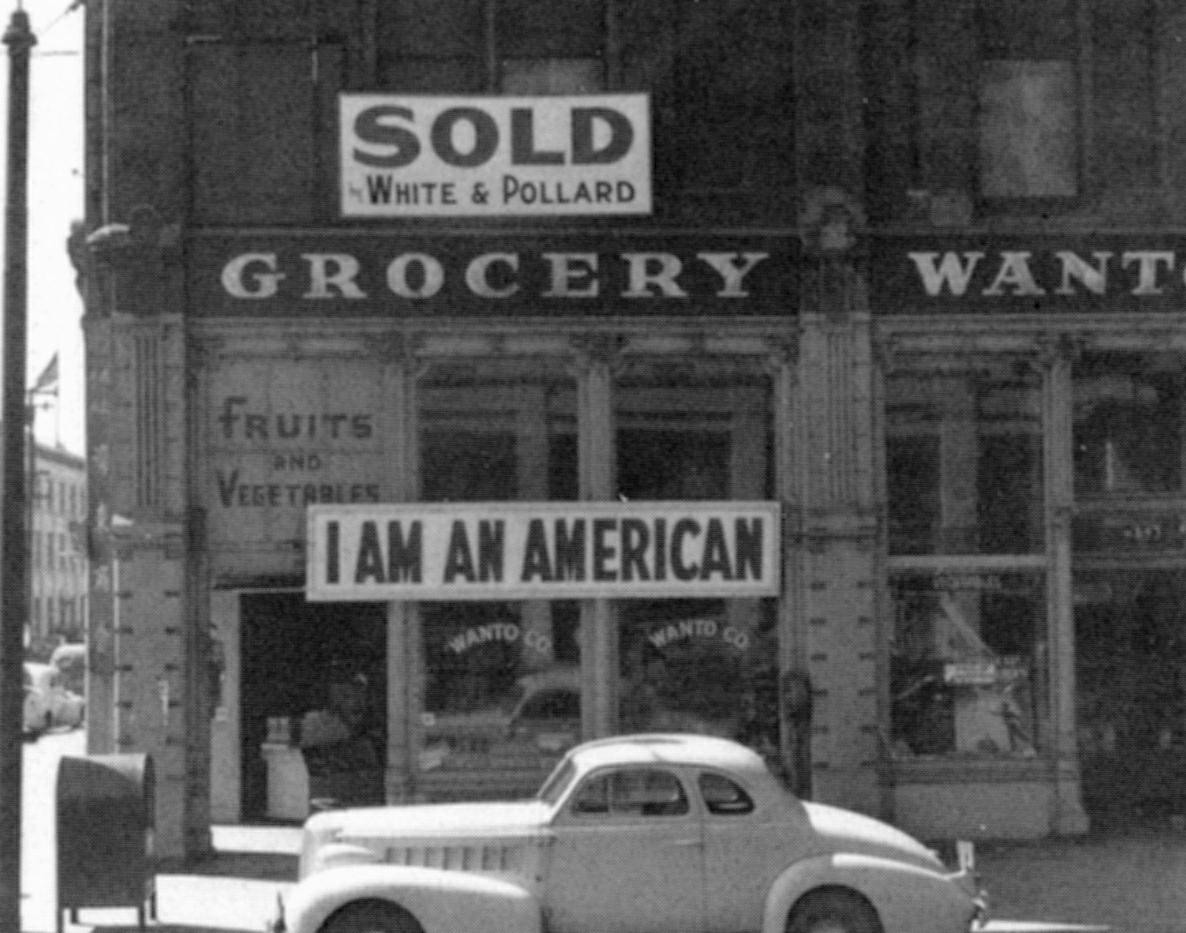
Japanese-American store sold
- 1942
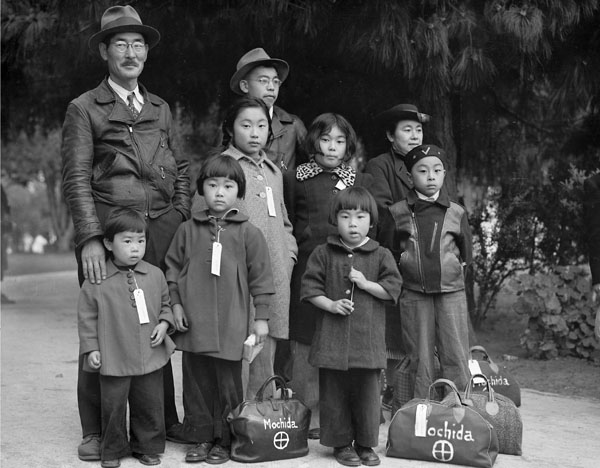 "Members of the Mochida family
awaiting evacuation bus. Identification tags
were used to aid in keeping a
family unit intact during all phases of
evacuation. Mochida operated a nursery and five
greenhouses
on a two-acre site in Eden
Township." By Dorothea
Lange, Hayward,
California, May 8, 1942
"Members of the Mochida family
awaiting evacuation bus. Identification tags
were used to aid in keeping a
family unit intact during all phases of
evacuation. Mochida operated a nursery and five
greenhouses
on a two-acre site in Eden
Township." By Dorothea
Lange, Hayward,
California, May 8, 1942
National Archives
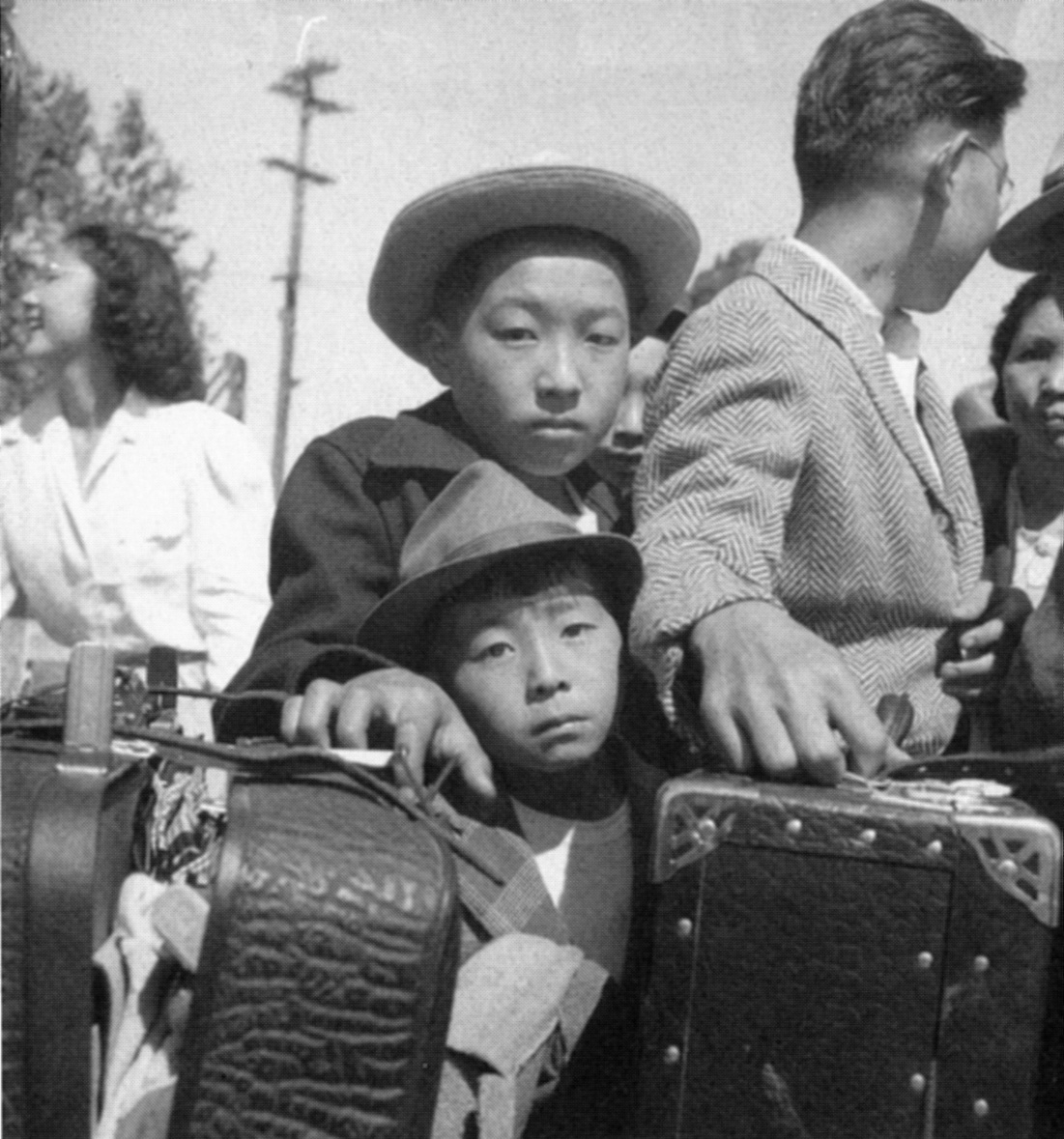
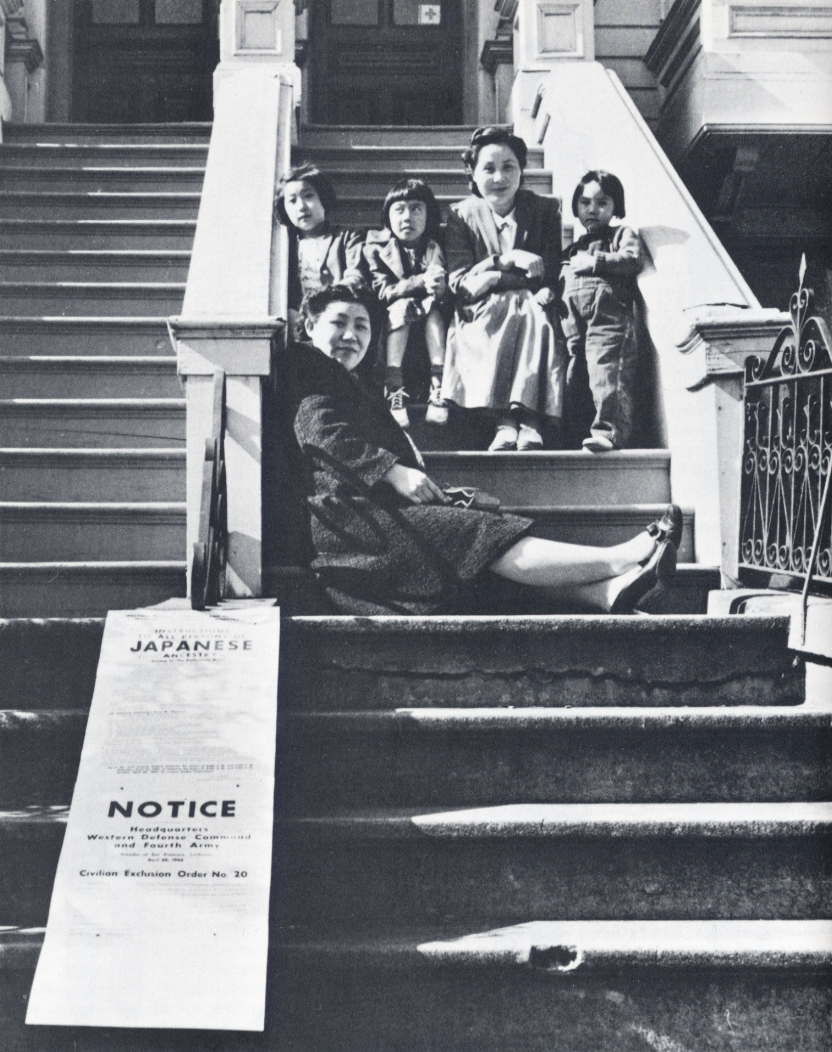
A San Francisco Japanese-American
family awaiting relocation
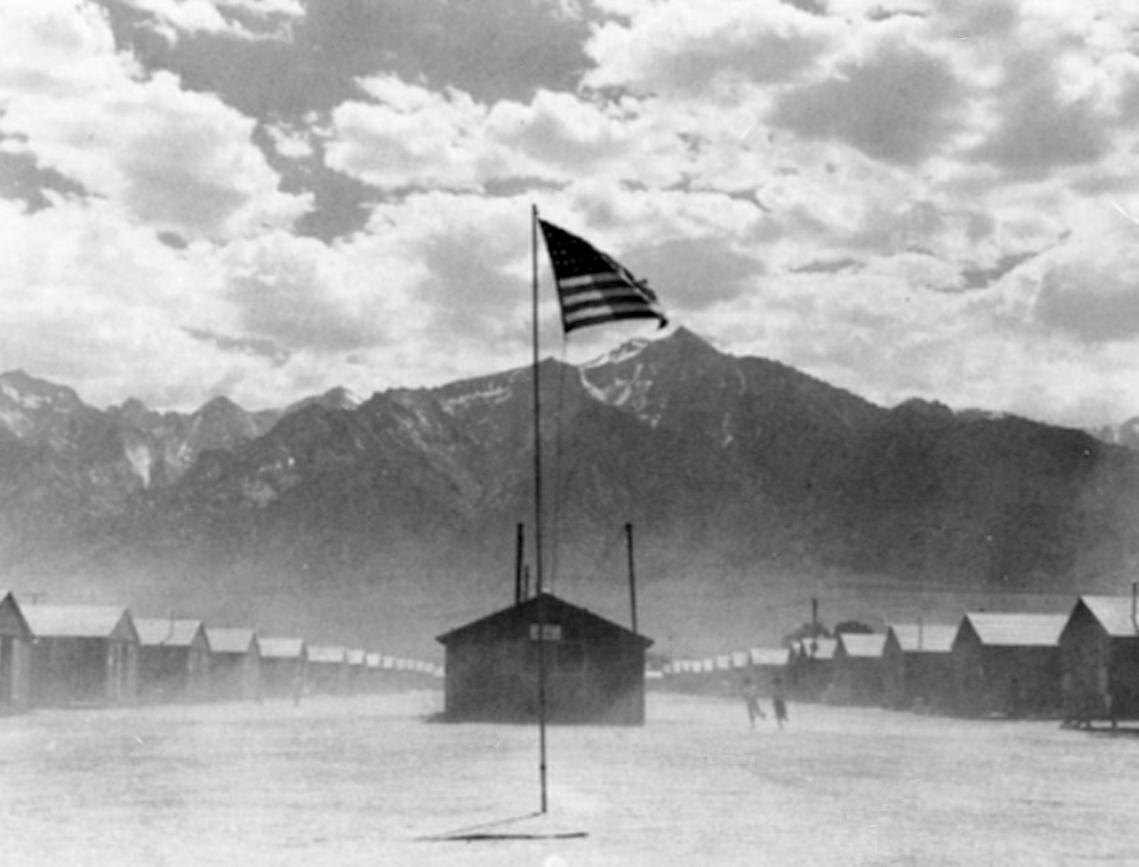
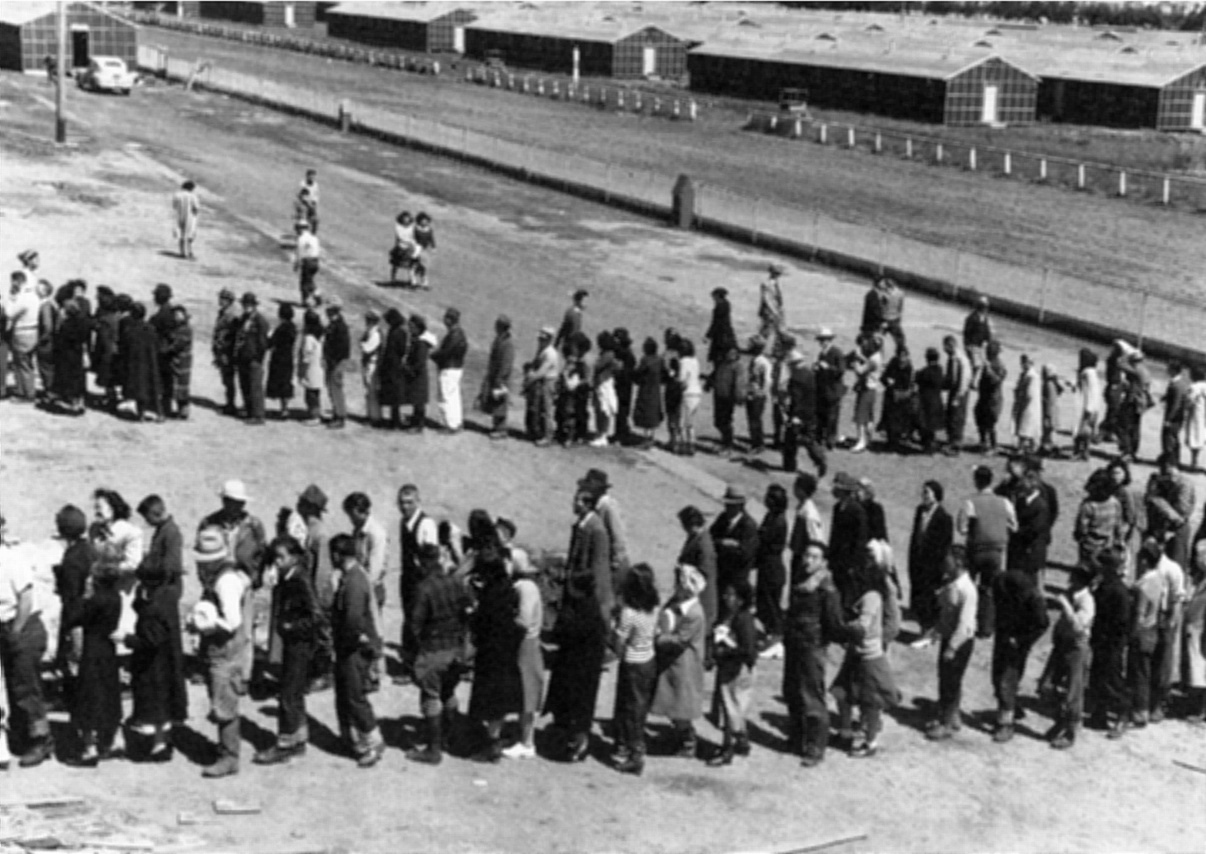

Go on to the next section: The War in Asia and the Pacific
 Miles
H. Hodges Miles
H. Hodges
| | | | |


 The Atlantic Charter (August 1941)
The Atlantic Charter (August 1941)
 Growing Japanese-American tensions
Growing Japanese-American tensions
 "A date that will live in infamy"
"A date that will live in infamy" America cranks up the industrial war
America cranks up the industrial war













































































